- Thesis Action Plan New
- Academic Project Planner

Literature Navigator
Thesis dialogue blueprint, writing wizard's template, research proposal compass.
- Why students love us
- Rebels Blog
- Why we are different
- All Products
- Coming Soon
Creating an Effective Thesis Outline: A Step-by-Step Guide

Creating a thesis outline might seem like a big job, but it makes the whole writing process a lot easier. This guide will show you each step to make a good thesis outline. From understanding why you need an outline to avoiding common mistakes, this article will help you stay organized and focused. By following these steps, you can make a strong outline that will guide your research and writing.
Key Takeaways
- A thesis outline helps you organize your thoughts and makes the writing process smoother.
- Start with initial research to find key themes and questions for your thesis.
- Structure your outline logically to ensure a clear flow of ideas.
- Revise your outline regularly to make sure it stays relevant and focused.
- Avoid common pitfalls like overloading with information or ignoring feedback.
Understanding the Purpose of a Thesis Outline
Creating a thesis outline is a crucial step in the academic writing process. It serves as a roadmap for your research , helping you organize your thoughts and structure your work logically . This section will delve into the purpose of a thesis outline, its importance in academic writing , and how it guides the research process.
Preliminary Steps Before Creating a Thesis Outline

Before diving into the creation of your thesis outline, it's essential to take some preliminary steps. These steps will lay a solid foundation for your research and ensure that your outline is both comprehensive and effective.
Structuring Your Thesis Outline
Creating a well-organized thesis outline is crucial for a successful thesis. It helps you structure your thoughts and ensures a logical flow of information. Here are the key steps to structuring your thesis outline effectively :
Choosing the Right Format
Selecting the appropriate format for your thesis outline is the first step. Common formats include alphanumeric, decimal, and full-sentence outlines. Choose a format that best suits your research and writing style. This decision will guide the organization of your major sections and sub-sections.
Organizing Major Sections
Divide your thesis into major sections such as the introduction, literature review, methodology, results, discussion, and conclusion. Each section should have a clear purpose and contribute to your overall thesis argument. Use headings and subheadings to break down each section into manageable parts.
Ensuring Logical Flow
A logical flow is essential for maintaining the reader's interest and understanding. Arrange your sections and sub-sections in a way that naturally progresses from one idea to the next. This will help you build a coherent argument and make your thesis more persuasive.
By following these steps, you can create a structured and effective thesis outline that will serve as a roadmap for your research and writing process.
Developing the Introduction Section
Crafting a compelling opening.
Your introduction should grab the reader's attention right from the start. Use a hook, such as a surprising fact or a thought-provoking question, to draw them in. This section sets the stage for your entire thesis, so make it engaging and relevant.
Presenting the Research Question
Clearly state the research question your thesis aims to answer. This question will guide your entire study and keep you focused. Make sure it is specific and researchable.
Outlining the Scope and Objectives
Provide an overview of the scope of your research. Explain what you will cover and what you will not. This helps set clear boundaries for your study. Additionally, outline the main objectives you aim to achieve with your research. Setting clear objectives will help you stay on track and ensure your research is focused and relevant.
Outlining the Literature Review

Summarizing Existing Research
When outlining your literature review , start by summarizing the existing research related to your topic. This involves gathering and synthesizing information from various sources, such as books, journal articles, and online databases. A well-summarized literature review provides a comprehensive overview of what has been done in your field and highlights the key findings and methodologies used by other researchers.
Identifying Research Gaps
After summarizing the existing research, the next step is to identify the gaps in the literature. These gaps represent areas where further research is needed and can help you position your study within the broader academic context. Look for questions that have not been answered or areas that have not been explored in depth. Identifying these gaps will not only justify the need for your research but also guide your research questions and objectives.
Establishing Theoretical Frameworks
Finally, establish the theoretical frameworks that will underpin your study. This involves selecting and discussing the theories and models that are relevant to your research topic. The theoretical framework provides a foundation for your study and helps to explain the relationships between different variables. By clearly outlining the theoretical frameworks, you can ensure that your research is grounded in established knowledge and contributes to the ongoing academic discourse.
Detailing the Methodology
Selecting research methods.
Choosing the right research methods is crucial for the success of your thesis. Start by deciding whether your study will be qualitative, quantitative, or a mix of both. Qualitative methods often include interviews and observations, while quantitative methods might involve surveys and experiments. Your choice should align with your research objectives and the type of data you need to collect.
Justifying Methodological Choices
Once you have selected your methods, it's important to justify why these methods are appropriate for your study. Explain how they will help you answer your research questions and achieve your objectives. This step is vital for gaining approval from stakeholders and ensuring the success of your project.
Describing Data Collection and Analysis
Detail the process of data collection and analysis . Describe the tools and techniques you will use, such as surveys, interviews, or software for data analysis. Make sure to explain how you will ensure the reliability and validity of your data. This section should provide a clear roadmap of how you will gather and interpret your data, ensuring that your research is both credible and replicable.
Presenting Research Findings
Organizing data logically.
When presenting your research findings, it's crucial to organize your data in a logical manner. This can be done by structuring your findings around key questions, hypotheses, or the overall structure of your study. Clear organization helps your audience understand your results without confusion. Consider using tables to present quantitative data succinctly.
Highlighting Key Results
Focus on the most significant results of your research. Highlight these key findings to ensure they stand out to your readers. This not only emphasizes the importance of your work but also makes it easier for others to grasp the core contributions of your study. Remember, clarity is essential in effective communication.
Using Visual Aids Effectively
Visual aids such as charts, graphs, and tables can greatly enhance the presentation of your research findings. They provide a visual representation of your data, making complex information more accessible. Ensure that your visual aids are well-labeled and directly related to the findings you are discussing. This will help in stripping the dread from data interpretation for your audience.
Analyzing and Discussing Results
Interpreting findings.
When you interpret your findings, you need to connect your analysis to your research questions and hypotheses. This involves making sense of statistical significance and drawing meaningful conclusions. Interpreting your findings helps you understand the broader implications of your research and how it contributes to the existing body of knowledge.
Comparing with Existing Literature
To provide context for your results, compare them with similar studies mentioned in your literature review. Highlight whether your findings align with or differ from previous research. This comparison can help validate your results and show how your work fits into the larger academic conversation.
Discussing Implications
Discuss the broader implications of your findings. Consider how they impact your field of study and what they mean for future research. This section should also address any limitations of your study and suggest areas for further investigation. By doing so, you demonstrate the significance of your research and its potential to influence future work.
Concluding Your Thesis
Summarizing key points.
In the conclusion, you should summarize the key points of your research. This involves revisiting the main arguments and findings discussed in your thesis. By doing so, you provide a clear and concise overview of your work, ensuring that the reader understands the significance of your research.
Restating the Thesis Statement
Restate your thesis statement in a fresh way , reflecting on how your research has supported or challenged it. This is crucial for reinforcing the main idea of your thesis and demonstrating how your work contributes to the broader field of study. Remember, a well-restated thesis can leave a lasting impression on your readers.
Suggesting Areas for Future Research
Finally, suggest areas for future research. Identify any gaps or limitations in your study and propose how future research can address these issues. This not only highlights the importance of your work but also encourages further exploration and development in your field.
Revising and Refining the Outline
Seeking feedback.
Before finalizing your thesis outline, it's crucial to seek feedback from your advisor or peers. They can provide valuable insights and identify areas that may need improvement. Don't hesitate to ask for their opinions on the structure and content of your outline. This step ensures that your outline is clear and logical.
Making Necessary Adjustments
After receiving feedback, take the time to make necessary adjustments. This may involve reorganizing sections, adding or removing content, or clarifying certain points. A reverse outline can be particularly helpful in this stage. It involves outlining an existing draft to assess its structure and coherence. This technique allows you to see if your ideas flow logically and if any sections need further development.
Ensuring Cohesion and Coherence
Finally, ensure that your outline is cohesive and coherent. Each section should connect logically to the next, and your main points should be clearly articulated. Use a checklist to verify that your outline meets these criteria. This step is essential for creating a well-structured thesis that effectively communicates your research findings.
Common Pitfalls to Avoid
Overloading with information.
One common mistake is trying to include too much information. This can make your thesis overwhelming and difficult to follow. Focus on the most relevant data and arguments to support your thesis statement. Remember, quality over quantity is key.
Lack of Clear Focus
A thesis that lacks a clear focus can confuse readers and weaken your argument. Make sure your thesis statement is specific and that each section of your outline directly supports it. Staying focused will help you create a more compelling and coherent thesis.
Ignoring Feedback
Feedback from advisors and peers is invaluable. Ignoring it can lead to missed opportunities for improvement. Take the time to consider and incorporate constructive criticism . This will not only enhance the quality of your thesis but also help you grow as a researcher.
Writing a thesis can be tricky, and many students fall into common traps. Don't let stress and confusion hold you back. Our step-by-step Thesis Action Plan is here to guide you through every stage. Ready to make your thesis journey smoother? Visit our website to learn more and get started today!
Creating an effective thesis outline is a vital step in the thesis writing process. It helps you organize your thoughts, stay focused, and ensure that your research is thorough and well-structured. By breaking down your thesis into manageable sections, you can tackle each part with confidence and clarity. Remember, a well-crafted outline not only makes the writing process smoother but also enhances the overall quality of your thesis. Stay dedicated, seek guidance when needed, and take pride in your progress. With a solid outline, you are well on your way to producing a compelling and academically rigorous thesis.
Frequently Asked Questions
Why do i need a thesis outline.
A thesis outline helps you organize your ideas and ensures your writing is structured and focused. It breaks your project into smaller, manageable parts, making the writing process faster and less stressful.
What should I do before creating a thesis outline?
Before creating a thesis outline, conduct initial research, identify key themes and questions, and set clear objectives for your study.
How should I structure my thesis outline?
Your thesis outline should include the major sections: introduction, literature review, methodology, research findings, discussion, and conclusion. Ensure each section flows logically into the next.
What is the best way to start the introduction section?
Start your introduction with a compelling opening, present your research question, and outline the scope and objectives of your thesis.
How do I organize the literature review?
Organize your literature review by summarizing existing research, identifying research gaps, and establishing theoretical frameworks relevant to your study.
What should I include in the methodology section?
In the methodology section, describe your research methods, justify your methodological choices, and explain how you collected and analyzed your data.
How can I present my research findings effectively?
Present your research findings by organizing data logically, highlighting key results, and using visual aids like charts and graphs to make the information clear and engaging.
What should I do if I get stuck while writing my thesis?
If you get stuck, take a break, seek feedback from peers or advisors, and revisit your outline to ensure your thesis remains focused and coherent.

Discovering Statistics Using IBM SPSS Statistics: A Fun and Informative Guide

Unlocking the Power of Data: A Review of 'Essentials of Modern Business Statistics with Microsoft Excel'

Discovering Statistics Using SAS: A Comprehensive Review

Mastering the First Step: How to Start Your Thesis with Confidence

Thesis Revision Made Simple: Techniques for Perfecting Your Academic Work

Integrating Calm into Your Study Routine: The Power of Mindfulness in Education

Thesis Action Plan

How to Determine the Perfect Research Proposal Length
How do i start writing my thesis: a step-by-step guide.
- Blog Articles
- Affiliate Program
- Terms and Conditions
- Payment and Shipping Terms
- Privacy Policy
- Return Policy
© 2024 Research Rebels, All rights reserved.
Your cart is currently empty.
Have a language expert improve your writing
Run a free plagiarism check in 10 minutes, automatically generate references for free.
- Knowledge Base
- Dissertation
- Dissertation & Thesis Outline | Example & Free Templates
Dissertation & Thesis Outline | Example & Free Templates
Published on 8 June 2022 by Tegan George .
A thesis or dissertation outline is one of the most critical early steps in your writing process . It helps you to lay out and organise your ideas and can provide you with a roadmap for deciding what kind of research you’d like to undertake.
Generally, an outline contains information on the different sections included in your thesis or dissertation, such as:
- Your anticipated title
- Your abstract
- Your chapters (sometimes subdivided into further topics like literature review, research methods, avenues for future research, etc.)
In the final product, you can also provide a chapter outline for your readers. This is a short paragraph at the end of your introduction to inform readers about the organisational structure of your thesis or dissertation . This chapter outline is also known as a reading guide or summary outline.
Table of contents
How to outline your thesis or dissertation, dissertation and thesis outline templates, chapter outline example, sample sentences for your chapter outline, sample verbs for variation in your chapter outline, frequently asked questions about outlines.
While there are some inter-institutional differences, many outlines proceed in a fairly similar fashion.
- Working Title
- ‘Elevator pitch’ of your work (often written last).
- Introduce your area of study, sharing details about your research question, problem statement , and hypotheses . Situate your research within an existing paradigm or conceptual or theoretical framework .
- Subdivide as you see fit into main topics and sub-topics.
- Describe your research methods (e.g., your scope, population , and data collection ).
- Present your research findings and share about your data analysis methods.
- Answer the research question in a concise way.
- Interpret your findings, discuss potential limitations of your own research and speculate about future implications or related opportunities.
To help you get started, we’ve created a full thesis or dissertation template in Word or Google Docs format. It’s easy adapt it to your own requirements.
Download Word template Download Google Docs template

It can be easy to fall into a pattern of overusing the same words or sentence constructions, which can make your work monotonous and repetitive for your readers. Consider utilising some of the alternative constructions presented below.
Example 1: Passive construction
The passive voice is a common choice for outlines and overviews because the context makes it clear who is carrying out the action (e.g., you are conducting the research ). However, overuse of the passive voice can make your text vague and imprecise.
Example 2: IS-AV construction
You can also present your information using the ‘IS-AV’ (inanimate subject with an active verb) construction.
A chapter is an inanimate object, so it is not capable of taking an action itself (e.g., presenting or discussing). However, the meaning of the sentence is still easily understandable, so the IS-AV construction can be a good way to add variety to your text.
Example 3: The I construction
Another option is to use the ‘I’ construction, which is often recommended by style manuals (e.g., APA Style and Chicago style ). However, depending on your field of study, this construction is not always considered professional or academic. Ask your supervisor if you’re not sure.
Example 4: Mix-and-match
To truly make the most of these options, consider mixing and matching the passive voice , IS-AV construction , and ‘I’ construction .This can help the flow of your argument and improve the readability of your text.
As you draft the chapter outline, you may also find yourself frequently repeating the same words, such as ‘discuss’, ‘present’, ‘prove’, or ‘show’. Consider branching out to add richness and nuance to your writing. Here are some examples of synonyms you can use.
| Address | Describe | Imply | Refute |
| Argue | Determine | Indicate | Report |
| Claim | Emphasise | Mention | Reveal |
| Clarify | Examine | Point out | Speculate |
| Compare | Explain | Posit | Summarise |
| Concern | Formulate | Present | Target |
| Counter | Focus on | Propose | Treat |
| Define | Give | Provide insight into | Underpin |
| Demonstrate | Highlight | Recommend | Use |
A thesis or dissertation outline is one of the most critical first steps in your writing process. It helps you to lay out and organise your ideas and can provide you with a roadmap for deciding what kind of research you’d like to undertake.
When you mention different chapters within your text, it’s considered best to use Roman numerals for most citation styles. However, the most important thing here is to remain consistent whenever using numbers in your dissertation .
All level 1 and 2 headings should be included in your table of contents . That means the titles of your chapters and the main sections within them.
The contents should also include all appendices and the lists of tables and figures, if applicable, as well as your reference list .
Do not include the acknowledgements or abstract in the table of contents.
Cite this Scribbr article
If you want to cite this source, you can copy and paste the citation or click the ‘Cite this Scribbr article’ button to automatically add the citation to our free Reference Generator.
George, T. (2022, June 08). Dissertation & Thesis Outline | Example & Free Templates. Scribbr. Retrieved 26 August 2024, from https://www.scribbr.co.uk/thesis-dissertation/outline-thesis-dissertation/
Is this article helpful?
Tegan George
Other students also liked, dissertation table of contents in word | instructions & examples, how to write a dissertation proposal | a step-by-step guide, thesis & dissertation acknowledgements | tips & examples.
Reference management. Clean and simple.
How to structure a thesis

A typical thesis structure
1. abstract, 2. introduction, 3. literature review, 6. discussion, 7. conclusion, 8. reference list, frequently asked questions about structuring a thesis, related articles.
Starting a thesis can be daunting. There are so many questions in the beginning:
- How do you actually start your thesis?
- How do you structure it?
- What information should the individual chapters contain?
Each educational program has different demands on your thesis structure, which is why asking directly for the requirements of your program should be a first step. However, there is not much flexibility when it comes to structuring your thesis.
Abstract : a brief overview of your entire thesis.
Literature review : an evaluation of previous research on your topic that includes a discussion of gaps in the research and how your work may fill them.
Methods : outlines the methodology that you are using in your research.
Thesis : a large paper, or multi-chapter work, based on a topic relating to your field of study.
The abstract is the overview of your thesis and generally very short. This section should highlight the main contents of your thesis “at a glance” so that someone who is curious about your work can get the gist quickly. Take a look at our guide on how to write an abstract for more info.
Tip: Consider writing your abstract last, after you’ve written everything else.
The introduction to your thesis gives an overview of its basics or main points. It should answer the following questions:
- Why is the topic being studied?
- How is the topic being studied?
- What is being studied?
In answering the first question, you should know what your personal interest in this topic is and why it is relevant. Why does it matter?
To answer the "how", you should briefly explain how you are going to reach your research goal. Some prefer to answer that question in the methods chapter, but you can give a quick overview here.
And finally, you should explain "what" you are studying. You can also give background information here.
You should rewrite the introduction one last time when the writing is done to make sure it connects with your conclusion. Learn more about how to write a good thesis introduction in our thesis introduction guide .
A literature review is often part of the introduction, but it can be a separate section. It is an evaluation of previous research on the topic showing that there are gaps that your research will attempt to fill. A few tips for your literature review:
- Use a wide array of sources
- Show both sides of the coin
- Make sure to cover the classics in your field
- Present everything in a clear and structured manner
For more insights on lit reviews, take a look at our guide on how to write a literature review .
The methodology chapter outlines which methods you choose to gather data, how the data is analyzed and justifies why you chose that methodology . It shows how your choice of design and research methods is suited to answering your research question.
Make sure to also explain what the pitfalls of your approach are and how you have tried to mitigate them. Discussing where your study might come up short can give you more credibility, since it shows the reader that you are aware of its limitations.
Tip: Use graphs and tables, where appropriate, to visualize your results.
The results chapter outlines what you found out in relation to your research questions or hypotheses. It generally contains the facts of your research and does not include a lot of analysis, because that happens mostly in the discussion chapter.
Clearly visualize your results, using tables and graphs, especially when summarizing, and be consistent in your way of reporting. This means sticking to one format to help the reader evaluate and compare the data.
The discussion chapter includes your own analysis and interpretation of the data you gathered , comments on your results and explains what they mean. This is your opportunity to show that you have understood your findings and their significance.
Point out the limitations of your study, provide explanations for unexpected results, and note any questions that remain unanswered.
This is probably your most important chapter. This is where you highlight that your research objectives have been achieved. You can also reiterate any limitations to your study and make suggestions for future research.
Remember to check if you have really answered all your research questions and hypotheses in this chapter. Your thesis should be tied up nicely in the conclusion and show clearly what you did, what results you got, and what you learned. Discover how to write a good conclusion in our thesis conclusion guide .
At the end of your thesis, you’ll have to compile a list of references for everything you’ve cited above. Ideally, you should keep track of everything from the beginning. Otherwise, this could be a mammoth and pretty laborious task to do.
Consider using a reference manager like Paperpile to format and organize your citations. Paperpile allows you to organize and save your citations for later use and cite them in thousands of citation styles directly in Google Docs, Microsoft Word, or LaTeX:
🔲 Introduction
🔲 Literature review
🔲 Discussion
🔲 Conclusion
🔲 Reference list
The basic elements of a thesis are: Abstract, Introduction, Literature Review, Methods, Results, Discussion, Conclusion, and Reference List.
It's recommended to start a thesis by writing the literature review first. This way you learn more about the sources, before jumping to the discussion or any other element.
It's recommended to write the abstract of a thesis last, once everything else is done. This way you will be able to provide a complete overview of your work.
Usually, the discussion is the longest part of a thesis. In this part you are supposed to point out the limitations of your study, provide explanations for unexpected results, and note any questions that remain unanswered.
The order of the basic elements of a thesis are: 1. Abstract, 2. Introduction, 3. Literature Review, 4. Methods, 5. Results, 6. Discussion, 7. Conclusion, and 8. Reference List.

- Privacy Policy

Home » Thesis Format – Templates and Samples
Thesis Format – Templates and Samples
Table of contents.

Thesis Format
Thesis format refers to the structure and layout of a research thesis or dissertation. It typically includes several chapters, each of which focuses on a particular aspect of the research topic .
The exact format of a thesis can vary depending on the academic discipline and the institution, but some common elements include:
Introduction
Literature review, methodology.
The title page is the first page of a thesis that provides essential information about the document, such as the title, author’s name, degree program, university, and the date of submission. It is considered as an important component of a thesis as it gives the reader an initial impression of the document’s content and quality.
The typical contents of a title page in a thesis include:
- The title of the thesis: It should be concise, informative, and accurately represent the main topic of the research.
- Author’s name: This should be written in full and should be the same as it appears on official university records.
- Degree program and department: This should specify the type of degree (e.g., Bachelor’s, Master’s, or Doctoral) and the field of study (e.g., Computer Science, Psychology, etc.).
- University: The name of the university where the thesis is being submitted.
- Date of submission : The month and year of submission of the thesis.
- Other details that can be included on the title page include the name of the advisor, the name of the committee members, and any acknowledgments.
In terms of formatting, the title page should be centered horizontally and vertically on the page, with a consistent font size and style. The page margin for the title page should be at least 1 inch (2.54 cm) on all sides. Additionally, it is common practice to include the university logo or crest on the title page, and this should be placed appropriately.
Title of the Thesis in Title Case by Author’s Full Name in Title Case
A thesis submitted in partial fulfillment of the requirements for the degree of Master of Science in Department Name at the University Name
Month Year of Submission
An abstract is a brief summary of a thesis or research paper that provides an overview of the main points, methodology, and findings of the study. It is typically placed at the beginning of the document, after the title page and before the introduction.
The purpose of an abstract is to provide readers with a quick and concise overview of the research paper or thesis. It should be written in a clear and concise language, and should not contain any jargon or technical terms that are not easily understood by the general public.
Here’s an example of an abstract for a thesis:
Title: The Impact of Social Media on Mental Health among Adolescents
This study examines the impact of social media on mental health among adolescents. The research utilized a survey methodology and collected data from a sample of 500 adolescents aged between 13 and 18 years. The findings reveal that social media has a significant impact on mental health among adolescents, with frequent use of social media associated with higher levels of anxiety, depression, and low self-esteem. The study concludes that there is a need for increased awareness and education on the risks associated with excessive use of social media, and recommends strategies for promoting healthy social media habits among adolescents.
In this example, the abstract provides a concise summary of the thesis by highlighting the main points, methodology, and findings of the study. It also provides a clear indication of the significance of the study and its implications for future research and practice.
A table of contents is an essential part of a thesis as it provides the reader with an overview of the entire document’s structure and organization.
Here’s an example of how a table of contents might look in a thesis:
TABLE OF CONTENTS
I. INTRODUCTION ……………………………………………………..1
A. Background of the Study………………………………………..1
B. Statement of the Problem……………………………………….2
C. Objectives of the Study………………………………………..3
D. Research Questions…………………………………………….4
E. Significance of the Study………………………………………5
F. Scope and Limitations………………………………………….6
G. Definition of Terms……………………………………………7
II. LITERATURE REVIEW. ………………………………………………8
A. Overview of the Literature……………………………………..8
B. Key Themes and Concepts………………………………………..9
C. Gaps in the Literature………………………………………..10
D. Theoretical Framework………………………………………….11
III. METHODOLOGY ……………………………………………………12
A. Research Design………………………………………………12
B. Participants and Sampling……………………………………..13
C. Data Collection Procedures…………………………………….14
D. Data Analysis Procedures………………………………………15
IV. RESULTS …………………………………………………………16
A. Descriptive Statistics…………………………………………16
B. Inferential Statistics…………………………………………17
V. DISCUSSION ………………………………………………………18
A. Interpretation of Results………………………………………18
B. Discussion of Finding s …………………………………………19
C. Implications of the Study………………………………………20
VI. CONCLUSION ………………………………………………………21
A. Summary of the Study…………………………………………..21
B. Limitations of the Study……………………………………….22
C. Recommendations for Future Research……………………………..23
REFERENCES …………………………………………………………….24
APPENDICES …………………………………………………………….26
As you can see, the table of contents is organized by chapters and sections. Each chapter and section is listed with its corresponding page number, making it easy for the reader to navigate the thesis.
The introduction is a critical part of a thesis as it provides an overview of the research problem, sets the context for the study, and outlines the research objectives and questions. The introduction is typically the first chapter of a thesis and serves as a roadmap for the reader.
Here’s an example of how an introduction in a thesis might look:
Introduction:
The prevalence of obesity has increased rapidly in recent decades, with more than one-third of adults in the United States being classified as obese. Obesity is associated with numerous adverse health outcomes, including cardiovascular disease, diabetes, and certain cancers. Despite significant efforts to address this issue, the rates of obesity continue to rise. The purpose of this study is to investigate the relationship between lifestyle behaviors and obesity in young adults.
The study will be conducted using a mixed-methods approach, with both qualitative and quantitative data collection methods. The research objectives are to:
- Examine the relationship between lifestyle behaviors and obesity in young adults.
- Identify the key lifestyle factors that contribute to obesity in young adults.
- Evaluate the effectiveness of current interventions aimed at preventing and reducing obesity in young adults.
The research questions that will guide this study are:
- What is the relationship between lifestyle behaviors and obesity in young adults?
- Which lifestyle factors are most strongly associated with obesity in young adults?
- How effective are current interventions aimed at preventing and reducing obesity in young adults?
By addressing these research questions, this study aims to contribute to the understanding of the factors that contribute to obesity in young adults and to inform the development of effective interventions to prevent and reduce obesity in this population.
A literature review is a critical analysis and evaluation of existing literature on a specific topic or research question. It is an essential part of any thesis, as it provides a comprehensive overview of the existing research on the topic and helps to establish the theoretical framework for the study. The literature review allows the researcher to identify gaps in the current research, highlight areas that need further exploration, and demonstrate the importance of their research question.
April 9, 2023:
A search on Google Scholar for “Effectiveness of Online Learning during the COVID-19 Pandemic” yielded 1,540 results. Upon reviewing the first few pages of results, it is evident that there is a significant amount of literature on the topic. A majority of the studies focus on the experiences and perspectives of students and educators during the transition to online learning due to the pandemic.
One recent study published in the Journal of Educational Technology & Society (Liu et al., 2023) found that students who were already familiar with online learning tools and platforms had an easier time adapting to online learning than those who were not. However, the study also found that students who were not familiar with online learning tools were able to adapt with proper support from their teachers and institutions.
Another study published in Computers & Education (Tang et al., 2023) compared the academic performance of students in online and traditional classroom settings during the pandemic. The study found that while there were no significant differences in the grades of students in the two settings, students in online classes reported higher levels of stress and lower levels of satisfaction with their learning experience.
Methodology in a thesis refers to the overall approach and systematic process that a researcher follows to collect and analyze data in order to answer their research question(s) or achieve their research objectives. It includes the research design, data collection methods, sampling techniques, data analysis procedures, and any other relevant procedures that the researcher uses to conduct their research.
For example, let’s consider a thesis on the impact of social media on mental health among teenagers. The methodology for this thesis might involve the following steps:
Research Design:
The researcher may choose to conduct a quantitative study using a survey questionnaire to collect data on social media usage and mental health among teenagers. Alternatively, they may conduct a qualitative study using focus group discussions or interviews to gain a deeper understanding of the experiences and perspectives of teenagers regarding social media and mental health.
Sampling Techniques:
The researcher may use random sampling to select a representative sample of teenagers from a specific geographic location or demographic group, or they may use purposive sampling to select participants who meet specific criteria such as age, gender, or mental health status.
Data Collection Methods:
The researcher may use an online survey tool to collect data on social media usage and mental health, or they may conduct face-to-face interviews or focus group discussions to gather qualitative data. They may also use existing data sources such as medical records or social media posts.
Data Analysis Procedures:
The researcher may use statistical analysis techniques such as regression analysis to examine the relationship between social media usage and mental health, or they may use thematic analysis to identify key themes and patterns in the qualitative data.
Ethical Considerations: The researcher must ensure that their research is conducted in an ethical manner, which may involve obtaining informed consent from participants, protecting their confidentiality, and ensuring that their rights and welfare are respected.
In a thesis, the “Results” section typically presents the findings of the research conducted by the author. This section typically includes both quantitative and qualitative data, such as statistical analyses, tables, figures, and other relevant data.
Here are some examples of how the “Results” section of a thesis might look:
Example 1: A quantitative study on the effects of exercise on cardiovascular health
In this study, the author conducts a randomized controlled trial to investigate the effects of exercise on cardiovascular health in a group of sedentary adults. The “Results” section might include tables showing the changes in blood pressure, cholesterol levels, and other relevant indicators in the exercise and control groups over the course of the study. The section might also include statistical analyses, such as t-tests or ANOVA, to demonstrate the significance of the results.
Example 2: A qualitative study on the experiences of immigrant families in a new country
In this study, the author conducts in-depth interviews with immigrant families to explore their experiences of adapting to a new country. The “Results” section might include quotes from the interviews that illustrate the participants’ experiences, as well as a thematic analysis that identifies common themes and patterns in the data. The section might also include a discussion of the implications of the findings for policy and practice.
A thesis discussion section is an opportunity for the author to present their interpretation and analysis of the research results. In this section, the author can provide their opinion on the findings, compare them with other literature, and suggest future research directions.
For example, let’s say the thesis topic is about the impact of social media on mental health. The author has conducted a survey among 500 individuals and has found that there is a significant correlation between excessive social media use and poor mental health.
In the discussion section, the author can start by summarizing the main findings and stating their interpretation of the results. For instance, the author may argue that excessive social media use is likely to cause mental health problems due to the pressure of constantly comparing oneself to others, fear of missing out, and cyberbullying.
Next, the author can compare their results with other studies and point out similarities and differences. They can also identify any limitations in their research design and suggest future directions for research.
For example, the author may point out that their study only measured social media use and mental health at one point in time, and it is unclear whether one caused the other or whether there are other confounding factors. Therefore, they may suggest longitudinal studies that follow individuals over time to better understand the causal relationship.
Writing a conclusion for a thesis is an essential part of the overall writing process. The conclusion should summarize the main points of the thesis and provide a sense of closure to the reader. It is also an opportunity to reflect on the research process and offer suggestions for further study.
Here is an example of a conclusion for a thesis:
After an extensive analysis of the data collected, it is evident that the implementation of a new curriculum has had a significant impact on student achievement. The findings suggest that the new curriculum has improved student performance in all subject areas, and this improvement is particularly notable in math and science. The results of this study provide empirical evidence to support the notion that curriculum reform can positively impact student learning outcomes.
In addition to the positive results, this study has also identified areas for future research. One limitation of the current study is that it only examines the short-term effects of the new curriculum. Future studies should explore the long-term effects of the new curriculum on student performance, as well as investigate the impact of the curriculum on students with different learning styles and abilities.
Overall, the findings of this study have important implications for educators and policymakers who are interested in improving student outcomes. The results of this study suggest that the implementation of a new curriculum can have a positive impact on student achievement, and it is recommended that schools and districts consider curriculum reform as a means of improving student learning outcomes.
References in a thesis typically follow a specific format depending on the citation style required by your academic institution or publisher.
Below are some examples of different citation styles and how to reference different types of sources in your thesis:
In-text citation format: (Author, Year)
Reference list format for a book: Author, A. A. (Year of publication). Title of work: Capital letter also for subtitle. Publisher.
Example: In-text citation: (Smith, 2010) Reference list entry: Smith, J. D. (2010). The art of writing a thesis. Cambridge University Press.
Reference list format for a journal article: Author, A. A., Author, B. B., & Author, C. C. (Year of publication). Title of article. Title of Journal, volume number(issue number), page range.
Example: In-text citation: (Brown, 2015) Reference list entry: Brown, E., Smith, J., & Johnson, L. (2015). The impact of social media on academic performance. Journal of Educational Psychology, 108(3), 393-407.
In-text citation format: (Author page number)
Works Cited list format for a book: Author. Title of Book. Publisher, Year of publication.
Example: In-text citation: (Smith 75) Works Cited entry: Smith, John D. The Art of Writing a Thesis. Cambridge University Press, 2010.
Works Cited list format for a journal article: Author(s). “Title of Article.” Title of Journal, volume number, issue number, date, pages.
Example: In-text citation: (Brown 394) Works Cited entry: Brown, Elizabeth, et al. “The Impact of Social Media on Academic Performance.” Journal of Educational Psychology, vol. 108, no. 3, 2015, pp. 393-407.
Chicago Style
In-text citation format: (Author year, page number)
Bibliography list format for a book: Author. Title of Book. Place of publication: Publisher, Year of publication.
Example: In-text citation: (Smith 2010, 75) Bibliography entry: Smith, John D. The Art of Writing a Thesis. Cambridge: Cambridge University Press, 2010.
Bibliography list format for a journal article: Author. “Title of Article.” Title of Journal volume number, no. issue number (date): page numbers.
Example: In-text citation: (Brown 2015, 394) Bibliography entry: Brown, Elizabeth, John Smith, and Laura Johnson. “The Impact of Social Media on Academic Performance.” Journal of Educational Psychology 108, no. 3 (2015): 393-407.
Reference list format for a book: [1] A. A. Author, Title of Book. City of Publisher, Abbrev. of State: Publisher, year.
Example: In-text citation: [1] Reference list entry: A. J. Smith, The Art of Writing a Thesis. New York, NY: Academic Press, 2010.
Reference list format for a journal article: [1] A. A. Author, “Title of Article,” Title of Journal, vol. x, no. x, pp. xxx-xxx, Month year.
Example: In-text citation: [1] Reference list entry: E. Brown, J. D. Smith, and L. Johnson, “The Impact of Social Media on Academic Performance,” Journal of Educational Psychology, vol. 108, no. 3, pp. 393-407, Mar. 2015.
An appendix in a thesis is a section that contains additional information that is not included in the main body of the document but is still relevant to the topic being discussed. It can include figures, tables, graphs, data sets, sample questionnaires, or any other supplementary material that supports your thesis.
Here is an example of how you can format appendices in your thesis:
- Title page: The appendix should have a separate title page that lists the title, author’s name, the date, and the document type (i.e., thesis or dissertation). The title page should be numbered as the first page of the appendix section.
- Table of contents: If you have more than one appendix, you should include a separate table of contents that lists each appendix and its page number. The table of contents should come after the title page.
- Appendix sections: Each appendix should have its own section with a clear and concise title that describes the contents of the appendix. Each section should be numbered with Arabic numerals (e.g., Appendix 1, Appendix 2, etc.). The sections should be listed in the table of contents.
- Formatting: The formatting of the appendices should be consistent with the rest of the thesis. This includes font size, font style, line spacing, and margins.
- Example: Here is an example of what an appendix might look like in a thesis on the topic of climate change:
Appendix 1: Data Sources
This appendix includes a list of the primary data sources used in this thesis, including their URLs and a brief description of the data they provide.
Appendix 2: Survey Questionnaire
This appendix includes the survey questionnaire used to collect data from participants in the study.
Appendix 3: Additional Figures
This appendix includes additional figures that were not included in the main body of the thesis due to space limitations. These figures provide additional support for the findings presented in the thesis.
About the author
Muhammad Hassan
Researcher, Academic Writer, Web developer
You may also like

Informed Consent in Research – Types, Templates...

Dissertation Methodology – Structure, Example...

Tables in Research Paper – Types, Creating Guide...

Thesis – Structure, Example and Writing Guide

Research Design – Types, Methods and Examples

Limitations in Research – Types, Examples and...
- Meet the Mentors
- Get Involved
- Get the T-Shirt
- Life Science Marketing
- Community Marketing
- Custom Marketing
Join Us Sign up for our feature-packed newsletter today to ensure you get the latest expert help and advice to level up your lab work.
- Genomics & Epigenetics
- DNA / RNA Manipulation and Analysis
- Protein Expression & Analysis
- PCR & Real-time PCR
- Flow Cytometry
- Microscopy & Imaging
- Cells and Model Organisms
- Analytical Chemistry and Chromatography Techniques
- Chemistry for Biologists
- Basic Lab Skills & Know-how
- Equipment Mastery & Hacks
- Managing the Scientific Literature
- Career Development and Networking
- Dealing with Fellow Scientists
- Getting Funded
- Lab Statistics & Math
- Organization & Productivity
- Personal Development
- PhD Survival
- Soft Skills & Tools
- Software & Online Tools
- Survive & Thrive
- Taming the Literature
- Writing, Publishing & Presenting
- Software and Online Tools
Using Word to Write your Thesis: Creating an Outline
Get your thesis writing off to a great start by learning how to create a thesis outline in Microsoft Word.
Published November 26, 2020

Lauren has a PhD in Biochemistry from the University of Dundee .

When I started the third year of my Ph.D., and the thought of creating a thesis outline was looming, I was advised to attend a course to learn how to use Microsoft Word properly before I started writing .
I laughed! Of course, I knew how to use Word! Why on earth would I spend 3 hours at a course on something I already know how to do?
My friend was insistent that I should attend. Since she had never steered me wrong in the lab before, I figured it couldn’t hurt to see if there was a trick or two I could pick up along the way.
Initially, I was quietly despairing that the course was a waste of an afternoon, especially after hearing questions such as “How do you insert a table?”, but I persevered and, by the second half of the session, realized that I knew nothing about the advanced functions of Word that make writing a thesis that much easier.
Microscopy and Imaging
Revolutionize Your Imaging Workflow with EVOS M5000
From: Thermo Fisher
Genomics and Epigenetics
RNA-Seq for Any Organism
From: Zymo Research
Finding out how little I actually knew had me feeling down at first, with that “worst Ph.D. student ever” feeling sinking in. But after talking to other students, I soon found out that I wasn’t alone! Surprisingly, few people I spoke to (including several students who had just submitted theses) had any idea of how much of the work of thesis writing Word would do automatically (or auto-magically) for you.
In the hopes that I can make at least one student’s write-up less stressful, I’ve created several posts that will show you how to use Microsoft Word ‘s advanced functions to write your thesis. Today’s topic starts from the beginning.
Creating a Thesis Outline
The first trick that I found fantastically helpful in laying out thesis chapters is the Outlining function . Creating a thesis outline allows you to set out the headings for your chapters, sections, and subsections and provides an easy means of moving them about without having to copy and paste things all over your document. To use the outline function, click the “ View ” tab at the top of the Word menu and select “ Outline ”.

This will give you the outlining toolbar.

From here, you can start your thesis outline by jotting down your main headings for each chapter and building a plan for each section.
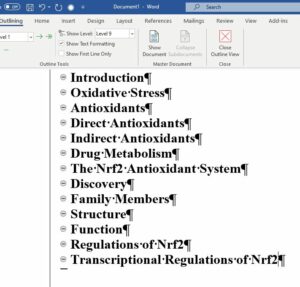
At this stage, you will have a very rough idea of the points you want to include. Now, you can designate the level or importance of each heading. The level will decide the size and type of font used for the heading and will be useful later on when you generate the table of contents.
Give it Some Style
Before you start assigning levels to the headings, decide how you want each level to look: e.g., the Chapter heading needs to be size 20, bold and underlined, level 2 section headings need to be size 18, bold, etc.
Then set up the style for each level:
- Close outline view
- Return to the home tab
- Go to the Styles gallery
- Right-click “ Heading 1 “
- Select “ Modify” and set up your preferred font styles
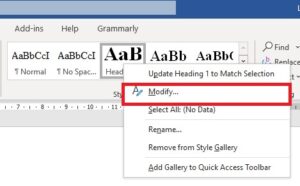
I found it useful to set this to “ New documents based on this template ” so that in each thesis chapter that I wrote, the headings were identical. You can also use the format option to make even more changes, like adjusting the line spacing and indents, or setting text to “keep with next” so paragraphs don’t break over a page or figures and legends don’t become separated.
Once you have this set up for each of the headings (I went as far as Heading 5 and didn’t need to go any further), you can set up the levels for your chapter headings within your thesis outline.
- Return to outline view
- Using the tool marked “ level ” use the single arrows on either side of it to promote or demote each heading a level, the double arrows move the headings to either end, i.e. Heading 1 or body text.

If you decide you need to move sections around, rather than copying and pasting, simply click the grey circle next to the heading and drag it to its new position.

Give Them Numbers
Next, you can add numbering to your headings. Still in outline view :
- Highlight all the headings in your thesis outline
- Click the Home tab and select “ multilevel list ” (located beside list numbering and bullet points)
- Select the type of numbering you want. I opted for the 1, 1.1, 1.1.1 format, but don’t be afraid to play around with other options if that’s not what you’re looking for.

With your thesis outline laid out for each chapter, it just becomes a matter of filling in the gaps. This will break your thesis into much more manageable chunks.
Pick a small section to write each week, and your thesis will practically write itself!
Stay tuned for my next post on generating a table of contents, inserting captions, and cross-referencing sections.
Originally published October 15, 2014. Reviewed and updated on November 22, 2020.
**Note: All screenshots taken from Word for Windows, 2019.
Share this article:
More 'Software and Online Tools' articles

Video Conferencing Services for Scientists
If to you Zoom is just a feature on a camera and BlueJeans is what you wear to work, then let us enlighten you.

10 Favorite Online Tools for Molecular Biology
What did we do before the internet? And where would we be without handy online molecular biology tools? Apparently in the ‘olden days’ doing a simple gene or protein alignment required programs that used dynamic programming algorithms such as the Needleman-Wunsch and Smith-Waterman algorithms. These required long processing times and the use of supercomputers or…

Reframing – A Way to Cope With Stress in Graduate School
I’m an anxiety-ridden stress ball 90% of the time. Graduate school only amplifies my nervous energy, and it’s a struggle. However, recently, while I rushed to catch a bus, I had a life altering experience using a mental technique called “reframing” From “Flipping Out” to Flipping the Switch to “Cool” It rained heavily. I balanced…
10 links: Free Mac Software for Molecular Biologists
I’ve put together this list of 10 pieces of free molecular biology software for Macs. I hope you will find at least some of it useful. If any of your favorite free programs are not included, please email me and I’ll add them or you can leave a comment with a link. If you are…

How to Get Over Impostor Syndrome as a New Graduate Student
You made it. You got into the grad school of your dreams! You worked hard, you spent hours working on your application, bravely navigated your way through the interview and you now are here. So, why do you feel like maybe you shouldn’t be? Why You Might Suffer From Impostor Syndrome The dreaded impostor syndrome:…

How to Pick a Great Postdoc Position
Are you finishing up your PhD and starting to think about the next step? It can be overwhelming to consider all of the personal and professional aspects involved in deciding and beginning this next stage of your career journey. With personal perspective from someone who has been there, here are some tips on how you…
We collate wisdom and tools from researchers worldwide to help you to accelerate your progress.
Sign up now to get it in your inbox
Newsletters
- Technical Skills
- More Skills
- Microscopy Focus
- Privacy Policy
- Cookie Policy
- Terms of Use
Copyright © Science Squared – all rights reserved
[WEBINAR] How to rapidly measure protein concentration from minimal volumes

- Langson Library
- Science Library
- Grunigen Medical Library
- Law Library
- Connect From Off-Campus
- Accessibility
- Gateway Study Center

Email this link
Thesis / dissertation formatting manual (2024).
- Filing Fees and Student Status
- Submission Process Overview
- Electronic Thesis Submission
- Paper Thesis Submission
- Formatting Overview
- Fonts/Typeface
- Pagination, Margins, Spacing
- Paper Thesis Formatting
- Preliminary Pages Overview
- Copyright Page
- Dedication Page
- Table of Contents
- List of Figures (etc.)
- Acknowledgments
- Text and References Overview
- Figures and Illustrations
- Using Your Own Previously Published Materials
- Using Copyrighted Materials by Another Author
- Open Access and Embargoes
- Copyright and Creative Commons
- Ordering Print (Bound) Copies
- Tutorials and Assistance
- FAQ This link opens in a new window
UCI Libraries maintains the following templates to assist in formatting your graduate manuscript. If you are formatting your manuscript in Microsoft Word, feel free to download and use the template. If you would like to see what your manuscript should look like, PDFs have been provided. If you are formatting your manuscript using LaTex, UCI maintains a template on OverLeaf.
- Annotated Template (Dissertation) 2024 PDF of a template with annotations of what to look out for
- Word: Thesis Template 2024 Editable template of the Master's thesis formatting.
- PDF Thesis Template 2024
- Word: Dissertation Template 2024 Editable template of the PhD Dissertation formatting.
- PDF: Dissertation Template 2024
- Overleaf (LaTex) Template
- << Previous: Tutorials and Assistance
- Next: FAQ >>
- Last Updated: Aug 26, 2024 11:00 AM
- URL: https://guides.lib.uci.edu/gradmanual
Off-campus? Please use the Software VPN and choose the group UCIFull to access licensed content. For more information, please Click here
Software VPN is not available for guests, so they may not have access to some content when connecting from off-campus.

How To Write A Dissertation Or Thesis
8 straightforward steps to craft an a-grade dissertation.
By: Derek Jansen (MBA) Expert Reviewed By: Dr Eunice Rautenbach | June 2020
Writing a dissertation or thesis is not a simple task. It takes time, energy and a lot of will power to get you across the finish line. It’s not easy – but it doesn’t necessarily need to be a painful process. If you understand the big-picture process of how to write a dissertation or thesis, your research journey will be a lot smoother.
In this post, I’m going to outline the big-picture process of how to write a high-quality dissertation or thesis, without losing your mind along the way. If you’re just starting your research, this post is perfect for you. Alternatively, if you’ve already submitted your proposal, this article which covers how to structure a dissertation might be more helpful.
How To Write A Dissertation: 8 Steps
- Clearly understand what a dissertation (or thesis) is
- Find a unique and valuable research topic
- Craft a convincing research proposal
- Write up a strong introduction chapter
- Review the existing literature and compile a literature review
- Design a rigorous research strategy and undertake your own research
- Present the findings of your research
- Draw a conclusion and discuss the implications

Step 1: Understand exactly what a dissertation is
This probably sounds like a no-brainer, but all too often, students come to us for help with their research and the underlying issue is that they don’t fully understand what a dissertation (or thesis) actually is.
So, what is a dissertation?
At its simplest, a dissertation or thesis is a formal piece of research , reflecting the standard research process . But what is the standard research process, you ask? The research process involves 4 key steps:
- Ask a very specific, well-articulated question (s) (your research topic)
- See what other researchers have said about it (if they’ve already answered it)
- If they haven’t answered it adequately, undertake your own data collection and analysis in a scientifically rigorous fashion
- Answer your original question(s), based on your analysis findings

In short, the research process is simply about asking and answering questions in a systematic fashion . This probably sounds pretty obvious, but people often think they’ve done “research”, when in fact what they have done is:
- Started with a vague, poorly articulated question
- Not taken the time to see what research has already been done regarding the question
- Collected data and opinions that support their gut and undertaken a flimsy analysis
- Drawn a shaky conclusion, based on that analysis
If you want to see the perfect example of this in action, look out for the next Facebook post where someone claims they’ve done “research”… All too often, people consider reading a few blog posts to constitute research. Its no surprise then that what they end up with is an opinion piece, not research. Okay, okay – I’ll climb off my soapbox now.
The key takeaway here is that a dissertation (or thesis) is a formal piece of research, reflecting the research process. It’s not an opinion piece , nor a place to push your agenda or try to convince someone of your position. Writing a good dissertation involves asking a question and taking a systematic, rigorous approach to answering it.
If you understand this and are comfortable leaving your opinions or preconceived ideas at the door, you’re already off to a good start!

Step 2: Find a unique, valuable research topic
As we saw, the first step of the research process is to ask a specific, well-articulated question. In other words, you need to find a research topic that asks a specific question or set of questions (these are called research questions ). Sounds easy enough, right? All you’ve got to do is identify a question or two and you’ve got a winning research topic. Well, not quite…
A good dissertation or thesis topic has a few important attributes. Specifically, a solid research topic should be:
Let’s take a closer look at these:
Attribute #1: Clear
Your research topic needs to be crystal clear about what you’re planning to research, what you want to know, and within what context. There shouldn’t be any ambiguity or vagueness about what you’ll research.
Here’s an example of a clearly articulated research topic:
An analysis of consumer-based factors influencing organisational trust in British low-cost online equity brokerage firms.
As you can see in the example, its crystal clear what will be analysed (factors impacting organisational trust), amongst who (consumers) and in what context (British low-cost equity brokerage firms, based online).
Need a helping hand?
Attribute #2: Unique
Your research should be asking a question(s) that hasn’t been asked before, or that hasn’t been asked in a specific context (for example, in a specific country or industry).
For example, sticking organisational trust topic above, it’s quite likely that organisational trust factors in the UK have been investigated before, but the context (online low-cost equity brokerages) could make this research unique. Therefore, the context makes this research original.
One caveat when using context as the basis for originality – you need to have a good reason to suspect that your findings in this context might be different from the existing research – otherwise, there’s no reason to warrant researching it.
Attribute #3: Important
Simply asking a unique or original question is not enough – the question needs to create value. In other words, successfully answering your research questions should provide some value to the field of research or the industry. You can’t research something just to satisfy your curiosity. It needs to make some form of contribution either to research or industry.
For example, researching the factors influencing consumer trust would create value by enabling businesses to tailor their operations and marketing to leverage factors that promote trust. In other words, it would have a clear benefit to industry.
So, how do you go about finding a unique and valuable research topic? We explain that in detail in this video post – How To Find A Research Topic . Yeah, we’ve got you covered 😊
Step 3: Write a convincing research proposal
Once you’ve pinned down a high-quality research topic, the next step is to convince your university to let you research it. No matter how awesome you think your topic is, it still needs to get the rubber stamp before you can move forward with your research. The research proposal is the tool you’ll use for this job.
So, what’s in a research proposal?
The main “job” of a research proposal is to convince your university, advisor or committee that your research topic is worthy of approval. But convince them of what? Well, this varies from university to university, but generally, they want to see that:
- You have a clearly articulated, unique and important topic (this might sound familiar…)
- You’ve done some initial reading of the existing literature relevant to your topic (i.e. a literature review)
- You have a provisional plan in terms of how you will collect data and analyse it (i.e. a methodology)
At the proposal stage, it’s (generally) not expected that you’ve extensively reviewed the existing literature , but you will need to show that you’ve done enough reading to identify a clear gap for original (unique) research. Similarly, they generally don’t expect that you have a rock-solid research methodology mapped out, but you should have an idea of whether you’ll be undertaking qualitative or quantitative analysis , and how you’ll collect your data (we’ll discuss this in more detail later).
Long story short – don’t stress about having every detail of your research meticulously thought out at the proposal stage – this will develop as you progress through your research. However, you do need to show that you’ve “done your homework” and that your research is worthy of approval .
So, how do you go about crafting a high-quality, convincing proposal? We cover that in detail in this video post – How To Write A Top-Class Research Proposal . We’ve also got a video walkthrough of two proposal examples here .
Step 4: Craft a strong introduction chapter
Once your proposal’s been approved, its time to get writing your actual dissertation or thesis! The good news is that if you put the time into crafting a high-quality proposal, you’ve already got a head start on your first three chapters – introduction, literature review and methodology – as you can use your proposal as the basis for these.
Handy sidenote – our free dissertation & thesis template is a great way to speed up your dissertation writing journey.
What’s the introduction chapter all about?
The purpose of the introduction chapter is to set the scene for your research (dare I say, to introduce it…) so that the reader understands what you’ll be researching and why it’s important. In other words, it covers the same ground as the research proposal in that it justifies your research topic.
What goes into the introduction chapter?
This can vary slightly between universities and degrees, but generally, the introduction chapter will include the following:
- A brief background to the study, explaining the overall area of research
- A problem statement , explaining what the problem is with the current state of research (in other words, where the knowledge gap exists)
- Your research questions – in other words, the specific questions your study will seek to answer (based on the knowledge gap)
- The significance of your study – in other words, why it’s important and how its findings will be useful in the world
As you can see, this all about explaining the “what” and the “why” of your research (as opposed to the “how”). So, your introduction chapter is basically the salesman of your study, “selling” your research to the first-time reader and (hopefully) getting them interested to read more.
How do I write the introduction chapter, you ask? We cover that in detail in this post .

Step 5: Undertake an in-depth literature review
As I mentioned earlier, you’ll need to do some initial review of the literature in Steps 2 and 3 to find your research gap and craft a convincing research proposal – but that’s just scratching the surface. Once you reach the literature review stage of your dissertation or thesis, you need to dig a lot deeper into the existing research and write up a comprehensive literature review chapter.
What’s the literature review all about?
There are two main stages in the literature review process:
Literature Review Step 1: Reading up
The first stage is for you to deep dive into the existing literature (journal articles, textbook chapters, industry reports, etc) to gain an in-depth understanding of the current state of research regarding your topic. While you don’t need to read every single article, you do need to ensure that you cover all literature that is related to your core research questions, and create a comprehensive catalogue of that literature , which you’ll use in the next step.
Reading and digesting all the relevant literature is a time consuming and intellectually demanding process. Many students underestimate just how much work goes into this step, so make sure that you allocate a good amount of time for this when planning out your research. Thankfully, there are ways to fast track the process – be sure to check out this article covering how to read journal articles quickly .

Literature Review Step 2: Writing up
Once you’ve worked through the literature and digested it all, you’ll need to write up your literature review chapter. Many students make the mistake of thinking that the literature review chapter is simply a summary of what other researchers have said. While this is partly true, a literature review is much more than just a summary. To pull off a good literature review chapter, you’ll need to achieve at least 3 things:
- You need to synthesise the existing research , not just summarise it. In other words, you need to show how different pieces of theory fit together, what’s agreed on by researchers, what’s not.
- You need to highlight a research gap that your research is going to fill. In other words, you’ve got to outline the problem so that your research topic can provide a solution.
- You need to use the existing research to inform your methodology and approach to your own research design. For example, you might use questions or Likert scales from previous studies in your your own survey design .
As you can see, a good literature review is more than just a summary of the published research. It’s the foundation on which your own research is built, so it deserves a lot of love and attention. Take the time to craft a comprehensive literature review with a suitable structure .
But, how do I actually write the literature review chapter, you ask? We cover that in detail in this video post .
Step 6: Carry out your own research
Once you’ve completed your literature review and have a sound understanding of the existing research, its time to develop your own research (finally!). You’ll design this research specifically so that you can find the answers to your unique research question.
There are two steps here – designing your research strategy and executing on it:
1 – Design your research strategy
The first step is to design your research strategy and craft a methodology chapter . I won’t get into the technicalities of the methodology chapter here, but in simple terms, this chapter is about explaining the “how” of your research. If you recall, the introduction and literature review chapters discussed the “what” and the “why”, so it makes sense that the next point to cover is the “how” –that’s what the methodology chapter is all about.
In this section, you’ll need to make firm decisions about your research design. This includes things like:
- Your research philosophy (e.g. positivism or interpretivism )
- Your overall methodology (e.g. qualitative , quantitative or mixed methods)
- Your data collection strategy (e.g. interviews , focus groups, surveys)
- Your data analysis strategy (e.g. content analysis , correlation analysis, regression)
If these words have got your head spinning, don’t worry! We’ll explain these in plain language in other posts. It’s not essential that you understand the intricacies of research design (yet!). The key takeaway here is that you’ll need to make decisions about how you’ll design your own research, and you’ll need to describe (and justify) your decisions in your methodology chapter.
2 – Execute: Collect and analyse your data
Once you’ve worked out your research design, you’ll put it into action and start collecting your data. This might mean undertaking interviews, hosting an online survey or any other data collection method. Data collection can take quite a bit of time (especially if you host in-person interviews), so be sure to factor sufficient time into your project plan for this. Oftentimes, things don’t go 100% to plan (for example, you don’t get as many survey responses as you hoped for), so bake a little extra time into your budget here.
Once you’ve collected your data, you’ll need to do some data preparation before you can sink your teeth into the analysis. For example:
- If you carry out interviews or focus groups, you’ll need to transcribe your audio data to text (i.e. a Word document).
- If you collect quantitative survey data, you’ll need to clean up your data and get it into the right format for whichever analysis software you use (for example, SPSS, R or STATA).
Once you’ve completed your data prep, you’ll undertake your analysis, using the techniques that you described in your methodology. Depending on what you find in your analysis, you might also do some additional forms of analysis that you hadn’t planned for. For example, you might see something in the data that raises new questions or that requires clarification with further analysis.
The type(s) of analysis that you’ll use depend entirely on the nature of your research and your research questions. For example:
- If your research if exploratory in nature, you’ll often use qualitative analysis techniques .
- If your research is confirmatory in nature, you’ll often use quantitative analysis techniques
- If your research involves a mix of both, you might use a mixed methods approach
Again, if these words have got your head spinning, don’t worry! We’ll explain these concepts and techniques in other posts. The key takeaway is simply that there’s no “one size fits all” for research design and methodology – it all depends on your topic, your research questions and your data. So, don’t be surprised if your study colleagues take a completely different approach to yours.

Step 7: Present your findings
Once you’ve completed your analysis, it’s time to present your findings (finally!). In a dissertation or thesis, you’ll typically present your findings in two chapters – the results chapter and the discussion chapter .
What’s the difference between the results chapter and the discussion chapter?
While these two chapters are similar, the results chapter generally just presents the processed data neatly and clearly without interpretation, while the discussion chapter explains the story the data are telling – in other words, it provides your interpretation of the results.
For example, if you were researching the factors that influence consumer trust, you might have used a quantitative approach to identify the relationship between potential factors (e.g. perceived integrity and competence of the organisation) and consumer trust. In this case:
- Your results chapter would just present the results of the statistical tests. For example, correlation results or differences between groups. In other words, the processed numbers.
- Your discussion chapter would explain what the numbers mean in relation to your research question(s). For example, Factor 1 has a weak relationship with consumer trust, while Factor 2 has a strong relationship.
Depending on the university and degree, these two chapters (results and discussion) are sometimes merged into one , so be sure to check with your institution what their preference is. Regardless of the chapter structure, this section is about presenting the findings of your research in a clear, easy to understand fashion.
Importantly, your discussion here needs to link back to your research questions (which you outlined in the introduction or literature review chapter). In other words, it needs to answer the key questions you asked (or at least attempt to answer them).
For example, if we look at the sample research topic:
In this case, the discussion section would clearly outline which factors seem to have a noteworthy influence on organisational trust. By doing so, they are answering the overarching question and fulfilling the purpose of the research .

For more information about the results chapter , check out this post for qualitative studies and this post for quantitative studies .
Step 8: The Final Step Draw a conclusion and discuss the implications
Last but not least, you’ll need to wrap up your research with the conclusion chapter . In this chapter, you’ll bring your research full circle by highlighting the key findings of your study and explaining what the implications of these findings are.
What exactly are key findings? The key findings are those findings which directly relate to your original research questions and overall research objectives (which you discussed in your introduction chapter). The implications, on the other hand, explain what your findings mean for industry, or for research in your area.
Sticking with the consumer trust topic example, the conclusion might look something like this:
Key findings
This study set out to identify which factors influence consumer-based trust in British low-cost online equity brokerage firms. The results suggest that the following factors have a large impact on consumer trust:
While the following factors have a very limited impact on consumer trust:
Notably, within the 25-30 age groups, Factors E had a noticeably larger impact, which may be explained by…
Implications
The findings having noteworthy implications for British low-cost online equity brokers. Specifically:
The large impact of Factors X and Y implies that brokers need to consider….
The limited impact of Factor E implies that brokers need to…
As you can see, the conclusion chapter is basically explaining the “what” (what your study found) and the “so what?” (what the findings mean for the industry or research). This brings the study full circle and closes off the document.

Let’s recap – how to write a dissertation or thesis
You’re still with me? Impressive! I know that this post was a long one, but hopefully you’ve learnt a thing or two about how to write a dissertation or thesis, and are now better equipped to start your own research.
To recap, the 8 steps to writing a quality dissertation (or thesis) are as follows:
- Understand what a dissertation (or thesis) is – a research project that follows the research process.
- Find a unique (original) and important research topic
- Craft a convincing dissertation or thesis research proposal
- Write a clear, compelling introduction chapter
- Undertake a thorough review of the existing research and write up a literature review
- Undertake your own research
- Present and interpret your findings
Once you’ve wrapped up the core chapters, all that’s typically left is the abstract , reference list and appendices. As always, be sure to check with your university if they have any additional requirements in terms of structure or content.

Psst... there’s more!
This post was based on one of our popular Research Bootcamps . If you're working on a research project, you'll definitely want to check this out ...
20 Comments
thankfull >>>this is very useful
Thank you, it was really helpful
unquestionably, this amazing simplified way of teaching. Really , I couldn’t find in the literature words that fully explicit my great thanks to you. However, I could only say thanks a-lot.
Great to hear that – thanks for the feedback. Good luck writing your dissertation/thesis.
This is the most comprehensive explanation of how to write a dissertation. Many thanks for sharing it free of charge.
Very rich presentation. Thank you
Thanks Derek Jansen|GRADCOACH, I find it very useful guide to arrange my activities and proceed to research!
Thank you so much for such a marvelous teaching .I am so convinced that am going to write a comprehensive and a distinct masters dissertation
It is an amazing comprehensive explanation
This was straightforward. Thank you!
I can say that your explanations are simple and enlightening – understanding what you have done here is easy for me. Could you write more about the different types of research methods specific to the three methodologies: quan, qual and MM. I look forward to interacting with this website more in the future.
Thanks for the feedback and suggestions 🙂
Hello, your write ups is quite educative. However, l have challenges in going about my research questions which is below; *Building the enablers of organisational growth through effective governance and purposeful leadership.*
Very educating.
Just listening to the name of the dissertation makes the student nervous. As writing a top-quality dissertation is a difficult task as it is a lengthy topic, requires a lot of research and understanding and is usually around 10,000 to 15000 words. Sometimes due to studies, unbalanced workload or lack of research and writing skill students look for dissertation submission from professional writers.
Thank you 💕😊 very much. I was confused but your comprehensive explanation has cleared my doubts of ever presenting a good thesis. Thank you.
thank you so much, that was so useful
Hi. Where is the excel spread sheet ark?
could you please help me look at your thesis paper to enable me to do the portion that has to do with the specification
my topic is “the impact of domestic revenue mobilization.
Submit a Comment Cancel reply
Your email address will not be published. Required fields are marked *
Save my name, email, and website in this browser for the next time I comment.
- Print Friendly
Library Subject Guides
4. writing up your research: thesis formatting (ms word).
- Books on Thesis Writing
- Thesis Formatting (MS Word)
- Referencing
| Other Research Support Guides >> >> >> >> |
Haere mai, tauti mai—welcome! These instructions are designed to be used with recent versions of MS Word. Please note there is no template or specific formatting guidelines for a thesis at UC. Please talk to your supervisor and take a look at theses in the UC Research Repository to see how they are usually formatted.
- Where to start
- Show/Hide Formatting
- Heading Styles
- Navigation Pane
- Table of Contents
- Numbered Headings
- List of Figures/Tables
- Page/Section Breaks, Page Numbering & Orientation
Word Thesis Formatting workshops run throughout the year.
Some useful documents.
- Word Formatting Instructions PDF This PDF contains the same instructions that are available on this page.
- Practice Thesis Document with No Formatting This pretend thesis file can be used to practise formatting. It is not a template for how to format a thesis . UC does not provide any guidelines on formatting a thesis.
Formatting in APA 7th Edition
For APA formatting advice see the official APA Style Blog's excellent Style and Grammar Guidelines . They cover most formatting topics with examples and sample papers, figures, and tables in Word documents you can download. Even more detail can be found in the Publication manual of the American Psychological Association that the Library has copies of.
Finding Examples
Look at examples and ask your supervisor.
The best guide on how to format your thesis is a combination of:
- Looking at previous theses in your discipline. Search the UC Research Repository for your subject or department, and browse by issue date to get the most recent.
- Asking your supervisor for recommendations on specific formatting and details.
General Recommendations
The following is an example only of preliminaries to the thesis that could be included.
- Acknowledgements
- List of Figures
- List of Tables
- Abbreviations
- Toggle show Home ->Show/Hide formatting

Using styles for headings allows you to create an automatic table of contents.
- Select major headings one at a time and choose Home ->Styles ‘Heading 1’

- Select subheadings and apply Home ->Styles ‘heading 2’ and ‘heading 3’
- Modify a style by right clicking on it and choosing Modify in the styles pane at the top of the screen.

The Navigation Pain is useful for seeing the outline of your document as well as providing links to quickly go to any section of the document.
- View->check Navigation Pane

In order to create an automatic table of contents heading styles must be used.
- References -> Table of Contents -> Custom Table of Contents (no heading in table)
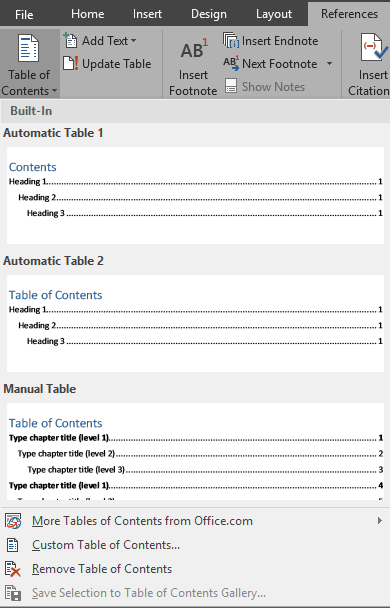
- Right click table of contents to ‘update field’ and choose ‘update entire table’
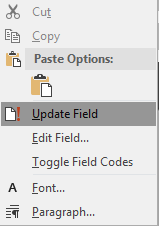
- Home->Multilevel list-> choose style with a number level for each heading level
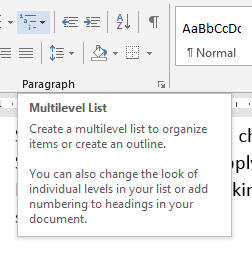
- To change the heading level 1 number to say ‘Chapter 1’ right click on heading level 1 in the styles area Heading 1->Modify .
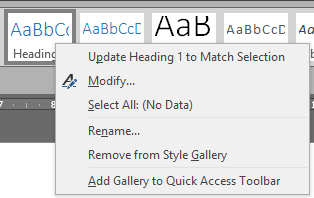
- In the modify screen click Format->Numbering.
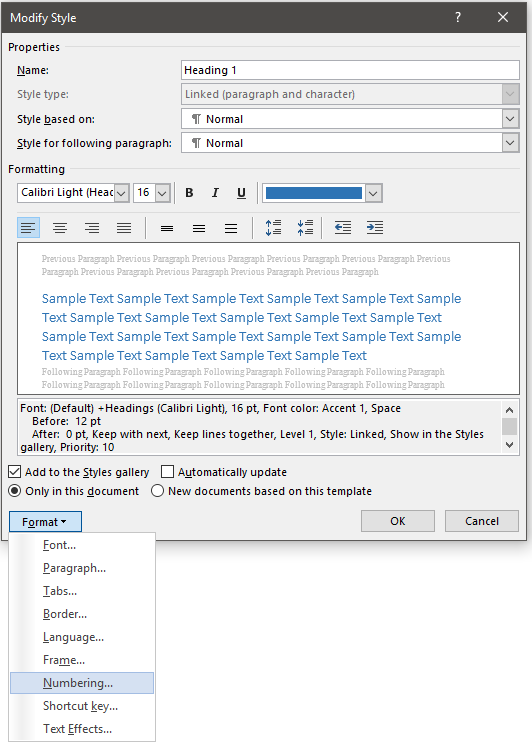
- Then click ‘ Define New Number Format’.
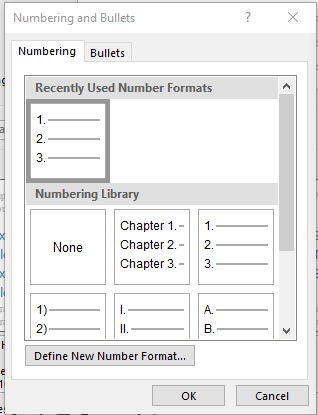
- Then add the word ‘Chapter’ and a space before the ‘1’.
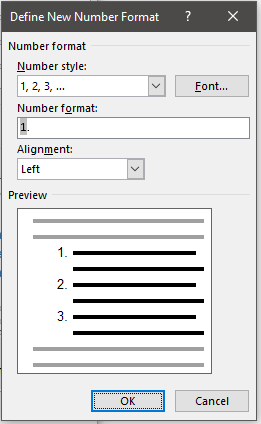
To create automatic lists of figures or tables you first have to give a caption to all your figures and tables.
- Right click figure or table and select Insert Caption
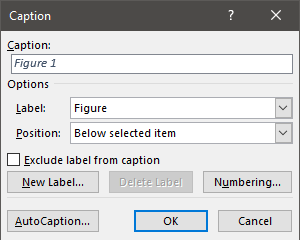
- Choose Label type eg. Figure, Table etc
- Choose position above or below
- Give the table or figure a title in the top box
- Go to the headings for List of Figures and List of tables and then click References->Insert Table of Figures -> select caption label type (Figure or Table)

- On the following menu select caption label type (Figure or Table) and click OK

This can be used to have different page numbering styles of different sections of your document or to have certain pages landscape to display a large table or graph.
- Insert a section break (next page) at the end of the title page ( Layout -> Breaks -> Next Page )
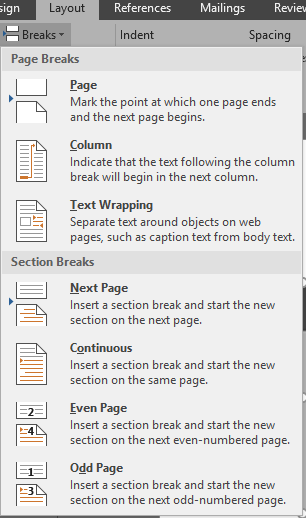
- Insert a section break at chapter 1 ( Layout -> Breaks -> Next Page )
- Insert page breaks for all other ‘heading 1’ headings ( Layout -> Breaks -> Page )
Adding Page Numbers
- Insert -> Page Number and choose a position on the page
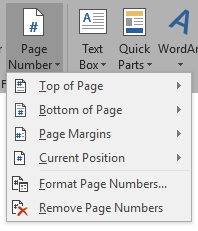
- Double click on title page header or footer (top or bottom of the page) and tick ‘ Different First Page’ in the Design ribbon that appears

- Click in second page header or footer, right click on the page number and select ‘ format page numbers ’
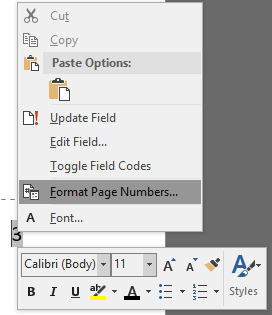
- Select Roman numerals eg. ‘i, ii, iii, iv’ etc
- Select start at ‘i’ (start at ‘1’)
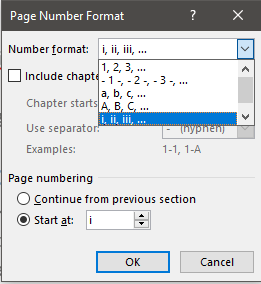
- Scroll to chapter 1 and change number style for this section back to ordinary numbers and start at 1
Change Page Orientation
- Insert a section break before and after the pages you want to change to landscape orientation (See instructions above for inserting a section break)
- Layout -> Orientation -> Landscape
NOTE: A section break is usually only needed if page orientation or separate page numbers are required.
| Workshops run throughout the year. |
- << Previous: Books on Thesis Writing
- Next: Referencing >>
- Last Updated: Jul 18, 2024 11:56 AM
- URL: https://canterbury.libguides.com/writingup
Purdue Online Writing Lab Purdue OWL® College of Liberal Arts
Tips and Examples for Writing Thesis Statements

Welcome to the Purdue OWL
This page is brought to you by the OWL at Purdue University. When printing this page, you must include the entire legal notice.
Copyright ©1995-2018 by The Writing Lab & The OWL at Purdue and Purdue University. All rights reserved. This material may not be published, reproduced, broadcast, rewritten, or redistributed without permission. Use of this site constitutes acceptance of our terms and conditions of fair use.
Tips for Writing Your Thesis Statement
1. Determine what kind of paper you are writing:
- An analytical paper breaks down an issue or an idea into its component parts, evaluates the issue or idea, and presents this breakdown and evaluation to the audience.
- An expository (explanatory) paper explains something to the audience.
- An argumentative paper makes a claim about a topic and justifies this claim with specific evidence. The claim could be an opinion, a policy proposal, an evaluation, a cause-and-effect statement, or an interpretation. The goal of the argumentative paper is to convince the audience that the claim is true based on the evidence provided.
If you are writing a text that does not fall under these three categories (e.g., a narrative), a thesis statement somewhere in the first paragraph could still be helpful to your reader.
2. Your thesis statement should be specific—it should cover only what you will discuss in your paper and should be supported with specific evidence.
3. The thesis statement usually appears at the end of the first paragraph of a paper.
4. Your topic may change as you write, so you may need to revise your thesis statement to reflect exactly what you have discussed in the paper.
Thesis Statement Examples
Example of an analytical thesis statement:
The paper that follows should:
- Explain the analysis of the college admission process
- Explain the challenge facing admissions counselors
Example of an expository (explanatory) thesis statement:
- Explain how students spend their time studying, attending class, and socializing with peers
Example of an argumentative thesis statement:
- Present an argument and give evidence to support the claim that students should pursue community projects before entering college
All Formats
Outline Templates
- 15+ Thesis Outline Templates – Sample, Example
A thesis outline templates is made to ensure that the plans for the creation of a thesis is put together in such a way that all the variables necessary to the scope of the study are considered appropriately. A thesis templates is a great help in making a great research analysis paper as it organizes the data as well.
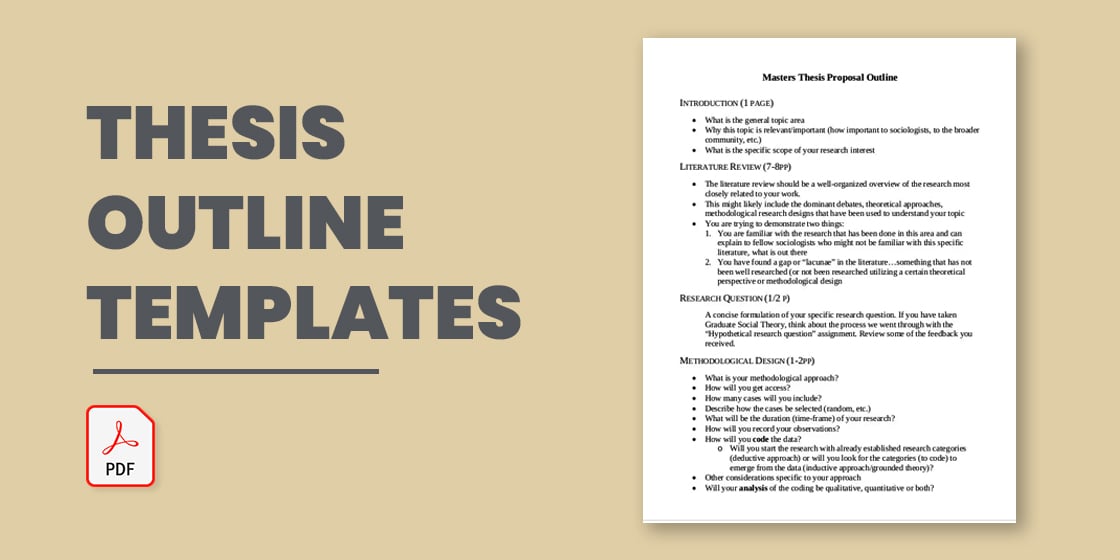
Thesis Proposal Outline Template

- Google Docs
- Apple Pages
Thesis Proposal Gantt Chart Outline Template
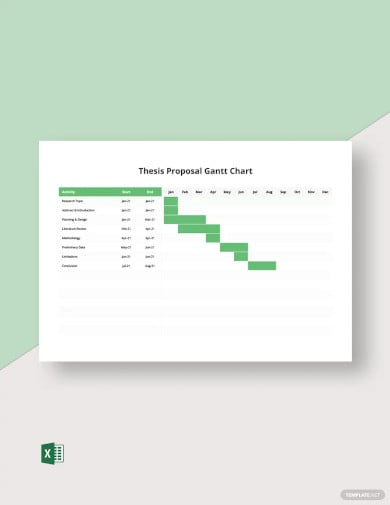
Free Master Thesis Outline Template
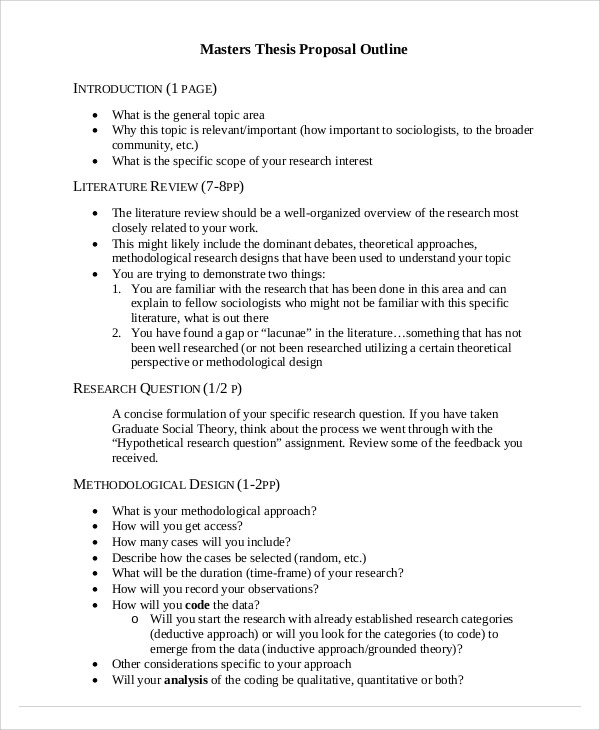
Free Traditional Senior Thesis Outline Template
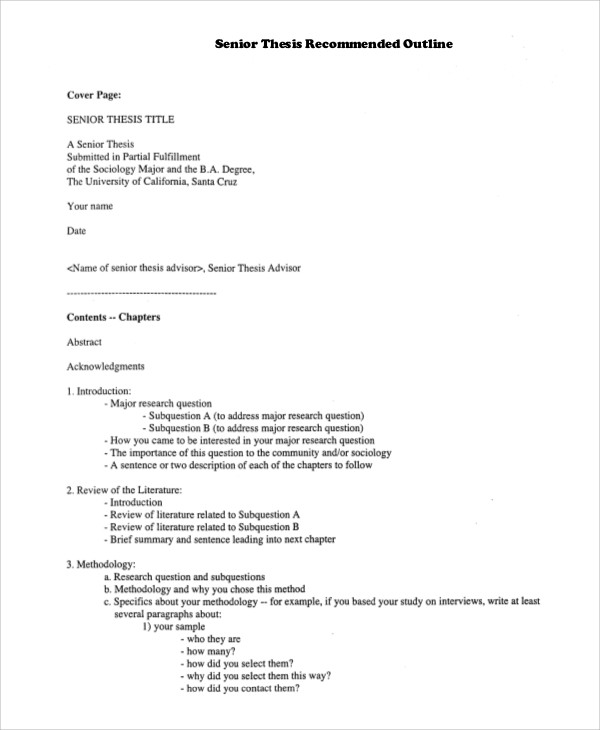
Thesis Outline Templates
- The topic of your thesis and the target audience.
- Then comes the introduction of the thesis and the thesis sample statement . The introduction includes a brief introduction to your thesis, and it should conclude with your thesis statement. A thesis statement is generally the last sentence of the introduction part.
- The body is the most important part of your thesis. Your entire content of the thesis should be included in the body of your thesis.
- Finally, the conclusion is written at the end of your thesis.
Free Thesis Statement Outline Template
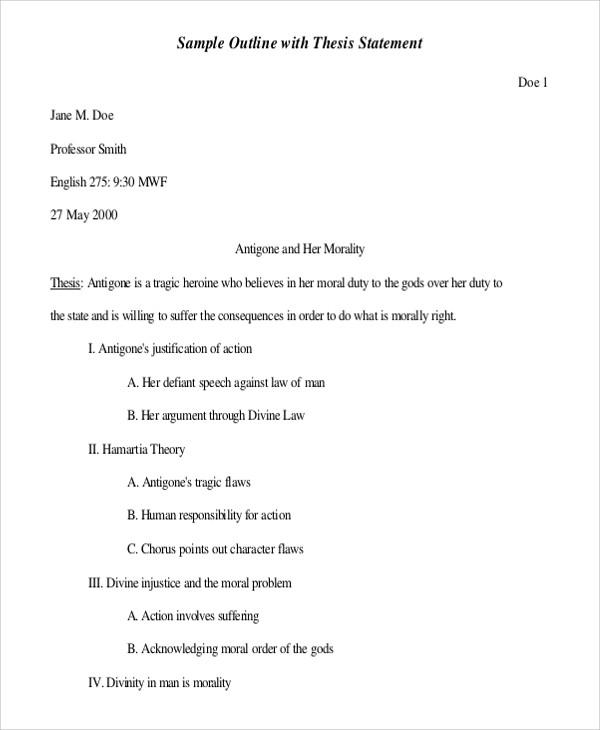
- Then comes the introduction of the thesis and the thesis personal statement . The introduction includes a brief introduction to your thesis, and it should conclude with your thesis sample statement . A thesis statement is generally the last sentence of the introduction part.
Free Outline for Thesis Proposal Template
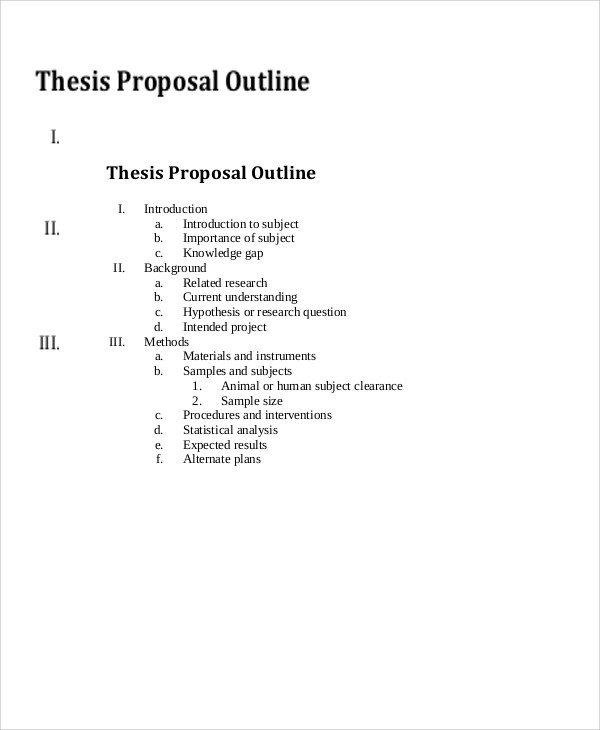
How to Create a Thesis Outline Template
- Be aware of the kind of thesis study that you would like to create so you can decide on the outline format that you may use.
- Download any of the outline templates that we have provided in this post so you can be guided by formatting the layout and content of your thesis outline template.
- Enumerate all the items that are needed to be present in your research and plot them accordingly on the formal template that you will use.
What Should a Thesis Outline Look Like
- It must contain the introduction of the research study.
- A literature review is essential to ensure the need for the study to push through.
- The research questions that need to be answered should also be stated.
- A methodological design must be included in the discussion within a thesis outline.
- The assessment sheet to be followed by the research study once information has already been gathered must also be presented
- Properly incorporate the way that a conclusion and recommendation may be stated based on the relation of the hypothesis to the results of the study. You can also see more on Email Outline .
Free University Honors Thesis Outline Template
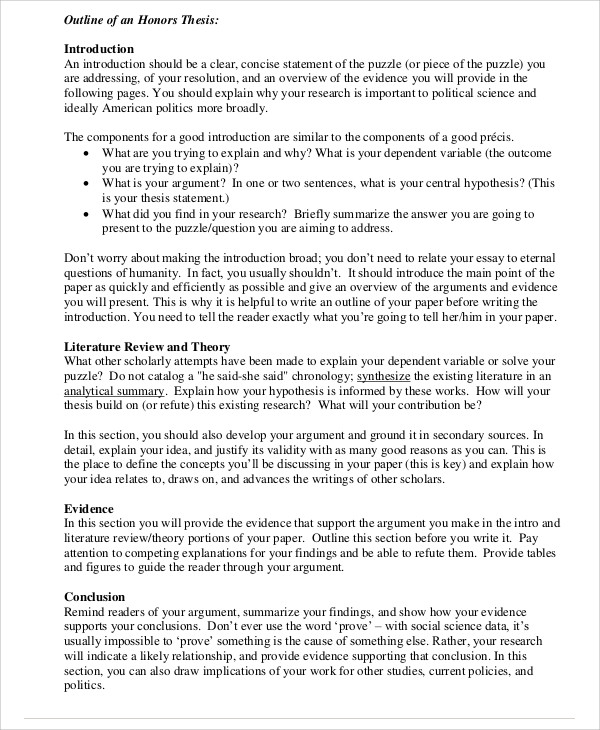
Free Sample Thesis Essay Outline Template
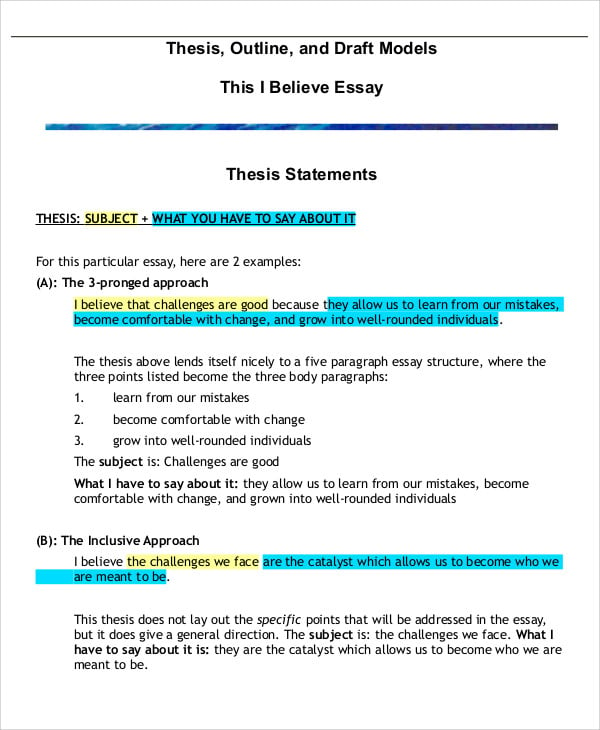
Free High School Academic Thesis Outline Template
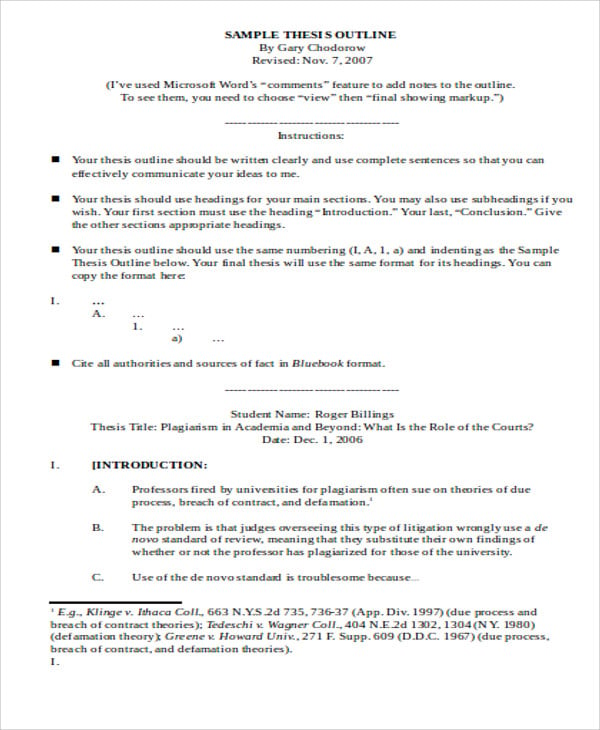
Free Thesis Paper Outline with Informative Introduction
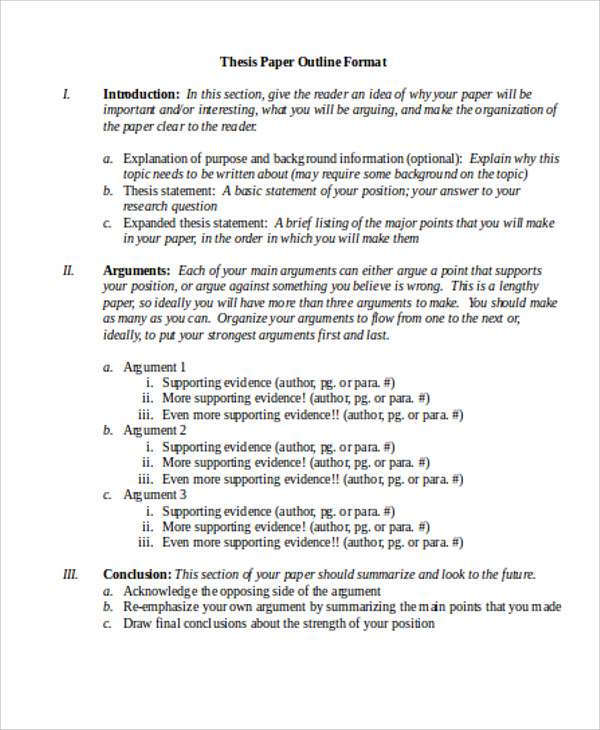
Free APA Thesis Outline Template
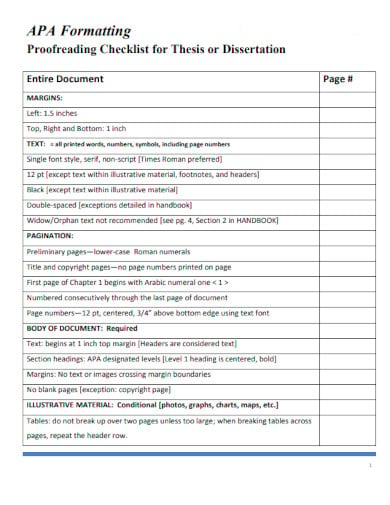
Free MLA Research Paper Thesis Outline Template
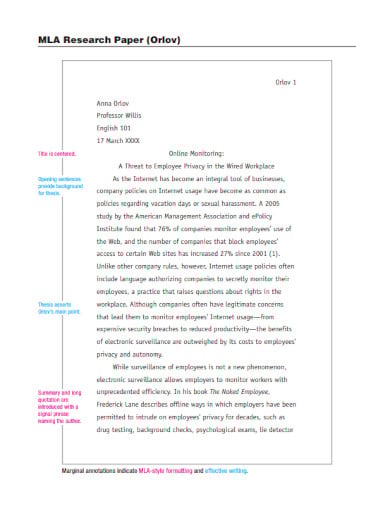
Free Student Thesis Outline Form Template
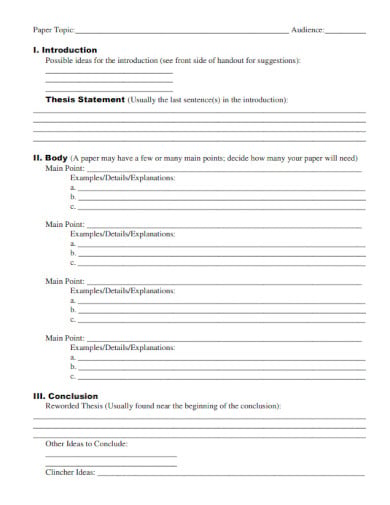
Free Baby Thesis Outline in PDF Format
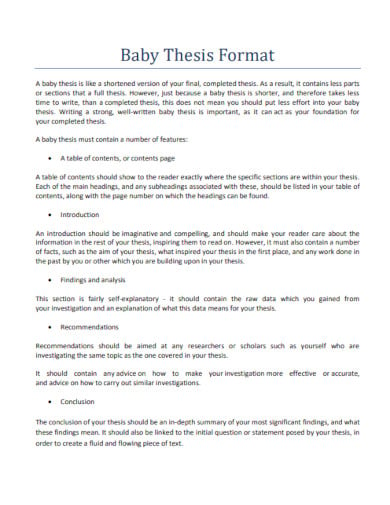
Free Environmental Science Thesis Outline Template
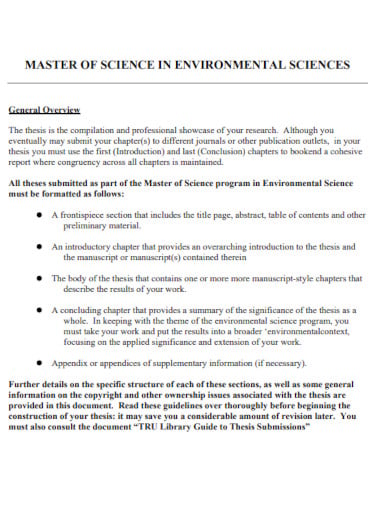
Guidelines in Creating a Thesis Outline
- Assure that the outline template that you will use may it be in MS Word format, PDF format, or MS Excel format is appropriate to the thesis or research study that you will conduct.
- Be precise with the items that you will put in the thesis outline and make sure that they are relevant to the study that you want to immerse yourself into. You can also see more on Sign Outline.
- Properly present the topic area which will generally be discussed and researched.
- Identify the reasons why the research is important. You can specify how it can benefit a community and the other stakeholders of the research activity.
- Be specific with the group of people to whom the results of the thesis will be highly usable.
- Your thesis outline must present the scope and limitations of the research interest. You can also see more on Memo Outline .
More in Outline Templates
- 10+ Training Outline Templates – PDF, Word, Apple Pages
- 24+ Autobiography Outline Templates & Samples – DOC, PDF
- 10+ Project Proposal Outline in Google Docs | MS Word | Pages | Editable PDF | InDesign | Photoshop | Publisher | PDF
- 12+ Literature Review Outline Templates – PDF, DOC
- 11+ Outline Report Templates in Google Docs | Word | Pages | PDF
- 10+ Production Outline Templates
- 12+ Project Outline Templates in Google Docs | Word | Pages | PDF | XLS
- 15+ Meeting Outline Templates in PDF | DOC
- 8+ Project Proposal Outline Templates
- 12+ Outline Templates in Apple Pages
- 10+ Outline Templates in Word
- 10+ Outline Templates
- 15+ Topic Proposal Outline Templates – PDF, Word
- 12+ Research Project Proposal Outline Templates – PDF, Word, Pages
File Formats
Word templates, google docs templates, excel templates, powerpoint templates, google sheets templates, google slides templates, pdf templates, publisher templates, psd templates, indesign templates, illustrator templates, pages templates, keynote templates, numbers templates, outlook templates.
On Laying Out your Thesis in InDesign
Most students in the school of architecture are fairly well versed in the use of InDesign for laying out documents. The thesis document that every master’s student needs to complete in order to acquire their degree is yet another one of these documents but with a few specific technical requirements that makes it a thesis book. Some of you may already know about all these features in InDesign and have your own way of putting together a book, but I’d like to share some of my experiences and methods I’ve learned while laying out my own thesis.
On requirements from the University:
I’ll begin at the beginning, the following are my notes on the formatting requirements from the university. It is advisable to take these into account early on so there are less formatting revisions required at the end for the submission to UWSpace. See this University of Waterloo webpage for the original information.
Typography:
- Font size – 10-12 (main) maybe smaller (footnotes/charts)
- Serif typeface (Times New Roman, Palatino etc.) – I kind of ignored this and it was ok
- Consistency in title, heading, footing.
- Each page should include a minimum 1 inch (72 points) margin at the top, bottom, and outer edge of each page. A minimum 1 1/8 inch (81 points) gutter margin should be included for printed copies. Wider margins, as part of an overall graphic design, are acceptable.
- Running headers may be placed outside the margins but not closer than 15mm from the outer edges of a page.
- Consistent British or American spelling
Organization:
- The page number is omitted from the Title page, although it is considered page i.
- Front matter pages are numbered with lower case Roman numerals, beginning with the Author’s Declaration (page ii) following the title page.
- Arabic numerals are used for all pages in the Text (main body) and Back matter.
- Each chapter/section must begin on a separate page.
- The text (main body) of the thesis begins with page number “1,” placed in the centre at the bottom . – this item is strict… must be centred bottom
- All pages in the Text (main body) and Back matter must be numbered consecutively.
Order of items
| Title page | i | RequiredDo not display the page number, however, the page must be accounted for |
| Author’s Declaration | ii | Required |
| Abstract | iii | RequiredOnly 1 Abstract must appear in the thesis located within the |
| Acknowledgements | iv | Required |
| Dedication | v | If applicable |
| Table of Contents | vi | Required |
| List of Figures | vii | If applicableEach figure in the text must be numbered; if the title/caption of the figure cannot fit on the same page as the figure, the title/caption may appear on the previous page facing the figure |
| List of Tables | viii | If applicableEach table in the text must be numbered; if the title/caption of the table cannot fit on the same page as the table, the title/caption may appear on the previous page facing the table |
| List of Illustrations | ix | If applicableEach illustration in the text must be numbered; if the title/caption of the illustration cannot fit on the same page as the illustration, the title/caption may appear on the previous page facing the illustration |
| List of Abbreviations | x | If applicable |
| List of Symbols | xi | If applicable |
| Nomenclature | xii | If applicable |
| Graphic or quote | xiii | If applicable |
| Footnotes (or Endnotes) may be included in the text | Arabic numerals must begin on the first page of and continue through to the last page of the | |
| Letters of copyright permission | If applicableIt is the student’s responsibility to determine if are required | |
| References (or Bibliography) | Only 1 Reference (or Bibliography) section must appear within the thesis located within the | |
| Appendices | If applicable | |
| Glossary | If applicable | |
| Index | If applicable | |
See this sample for details on formatting the title page
The Author’s Declaration page must appear as follows:
“I hereby declare that I am the sole author of this thesis. This is a true copy of the thesis, including any required final revisions, as accepted by my examiners. I understand that my thesis may be made electronically available to the public.”
Sourcing/ Bibliographies:
- use RefWorks… see librarian for help with resource if necessary
On setting up an InDesign book:
If you anticipate a large file for your thesis, it may be advisable to make separate InDesign documents for each chapter and then combining them into an InDesign book. This introduces a bit of complications but may be worth it if your computer starts to lag with the large file.
Making an InDesign book is fairly straightforward:
- When you create an InDesign document the first page is generally on the right hand side (an odd page), so when you combined the documents in a book using the “continue from previous page” option that right hand page may become a left hand page (an even page) and screw up the spread layout that you have designed
- Choosing either the “continue on next even/odd page” will allow the document to insert a blank page to the previous document if necessary to keep the spread layout in tact.
Note: you are able to sync all your paragraph and character styles to all your documents through the book control panel, you can set up all your styles in a designated master document and sync it to the rest. Alternatively, you can create a style in any document and import it to the master then sync it to the rest.
On using paragraph and character styles:
Styles are great to setup not just for consistent formatting but also for simplifying the hassle of doing referencing and figure listing, table of contents too – if you want to go that far.
First thing to know about styles is when to create a paragraph style vs. a character style:
Sample paragraph styles
Sample character styles
*The following sections will describe how you use these paragraph styles to create endnotes and generate a figure list
Character styles override the appearance of text in the paragraph styles, choosing [none] in character styles would revert the text back to the default character style set by the paragraph style. You can create paragraph and character styles as you see fit for your desired layout. InDesign uses paragraph styles to generate a Table of Contents that updates automatically when you edit the text or when the page number changes.
I was too late in my game to implement this, but there is a program called WordsFlow that allows Word documents to be synced in InDesign. This way, you can place the text, apply the formatting, edit the text and it will update on both Word and InDesign. Unfortunately, since I never used the program, I can’t vouch for the success of the program. However, if it does then you can simply use Word to do your endnotes and disregard the next section.
On doing endnotes with cross-references:
InDesign has the function to do footnotes under the “type” menu so I won’t go into that. Following is the method I used to make my endnotes and hyperlink them. There are probably other ways to accomplish this, I just found this the easiest.
Making endnotes*:
- Create a paragraph style called “endnotes”
- Place cursor where you want the endnote number to go in your text
- Repeat for other endnotes
* for a more detail guide, visit the following website .
On generating a figure list:
The figure list will inexplicably get pretty long and tedious to update. Using cross-reference and paragraph styles, you could generate a list that updates according to the figure description. This set up will also allow figure numbers to rearrange accordingly when you need to insert a new figure in-between two existing ones.
Making the figures:
- Create a paragraph style called “Figures”
- In “Number” type in ‘Figure’ in the field and edit the variables to your preference, you can use “Character Styles” to modify the appearance of the figure number
- Apply the paragraph style to text boxes that hold the descriptions and the figure numbers will appear in order
- There may be a better way to create this list, I still had to manually insert each cross reference but it saved the time of having to type each number and description out individually.
- I would still recommend doing this step closer to the end of the thesis as sometimes the update gets confused when the figure has shifted around a lot or removed.
*This step is important for the figure number to continue counting even when you create separate text frames, for a more detailed explanation visit this website.
Note: if you have set up a book, the file holding the figure list would lag due to the cross references to other files, the solution is to simply have all the files open when you working on the figure list so the computer isn’t trying to open each of the files in the background to check if the references are updated.
Lastly, if you export your pdf with hyperlinks enabled, readers of the digital copy can use the hyperlinks to jump to chapters, endnotes and even figures depending on what links you’ve set up.
I learned most of these tips through Youtube and Indesignsecrets.com , there are lots of good tips to be found. Hopefully this article is a nice comprehensive guide for starting to layout your thesis. Happy thesis writing!
About Vikkie Chen
Vikkie is a graduate student at the Waterloo School of Architecture researching the practice of curation and architectural exhibitions as a method of development for the field of architecture.
You also might be interested in
Thesis: kyle elderhorst – revision 2020: redefining public works in new york city’s sixth borough.
On March 14, 2011 the Bloomberg Administration unveiled New York[...]
Relinquish to Dust: A Centre for (w)Resting Grief in Toronto’s Community
As of June 24, 2014, Anna-Joy Veenstra’s completed thesis can[...]
THESIS: Monsoon Notebook: Exploring Home
Jaliya's thesis explores the meaning of home, and the role it plays in his relationship to architecture. It rests in the transitional space between Canada and his native Sri Lanka, where he spent three months rediscovering his connection to his birthplace. His thesis is entitled Monsoon Notebook, and it records, presents and re-presents his travels as a means of architectural grounding and self-discovery.
Leave a Reply Cancel Reply
Save my name, email, and website in this browser for the next time I comment.
This site uses Akismet to reduce spam. Learn how your comment data is processed .
© 2024 — BRIDGE.
Have a language expert improve your writing
Run a free plagiarism check in 10 minutes, generate accurate citations for free.
- Knowledge Base
- How to Write a Thesis Statement | 4 Steps & Examples
How to Write a Thesis Statement | 4 Steps & Examples
Published on January 11, 2019 by Shona McCombes . Revised on August 15, 2023 by Eoghan Ryan.
A thesis statement is a sentence that sums up the central point of your paper or essay . It usually comes near the end of your introduction .
Your thesis will look a bit different depending on the type of essay you’re writing. But the thesis statement should always clearly state the main idea you want to get across. Everything else in your essay should relate back to this idea.
You can write your thesis statement by following four simple steps:
- Start with a question
- Write your initial answer
- Develop your answer
- Refine your thesis statement
Instantly correct all language mistakes in your text
Upload your document to correct all your mistakes in minutes

Table of contents
What is a thesis statement, placement of the thesis statement, step 1: start with a question, step 2: write your initial answer, step 3: develop your answer, step 4: refine your thesis statement, types of thesis statements, other interesting articles, frequently asked questions about thesis statements.
A thesis statement summarizes the central points of your essay. It is a signpost telling the reader what the essay will argue and why.
The best thesis statements are:
- Concise: A good thesis statement is short and sweet—don’t use more words than necessary. State your point clearly and directly in one or two sentences.
- Contentious: Your thesis shouldn’t be a simple statement of fact that everyone already knows. A good thesis statement is a claim that requires further evidence or analysis to back it up.
- Coherent: Everything mentioned in your thesis statement must be supported and explained in the rest of your paper.
Receive feedback on language, structure, and formatting
Professional editors proofread and edit your paper by focusing on:
- Academic style
- Vague sentences
- Style consistency
See an example

The thesis statement generally appears at the end of your essay introduction or research paper introduction .
The spread of the internet has had a world-changing effect, not least on the world of education. The use of the internet in academic contexts and among young people more generally is hotly debated. For many who did not grow up with this technology, its effects seem alarming and potentially harmful. This concern, while understandable, is misguided. The negatives of internet use are outweighed by its many benefits for education: the internet facilitates easier access to information, exposure to different perspectives, and a flexible learning environment for both students and teachers.
You should come up with an initial thesis, sometimes called a working thesis , early in the writing process . As soon as you’ve decided on your essay topic , you need to work out what you want to say about it—a clear thesis will give your essay direction and structure.
You might already have a question in your assignment, but if not, try to come up with your own. What would you like to find out or decide about your topic?
For example, you might ask:
After some initial research, you can formulate a tentative answer to this question. At this stage it can be simple, and it should guide the research process and writing process .
Now you need to consider why this is your answer and how you will convince your reader to agree with you. As you read more about your topic and begin writing, your answer should get more detailed.
In your essay about the internet and education, the thesis states your position and sketches out the key arguments you’ll use to support it.
The negatives of internet use are outweighed by its many benefits for education because it facilitates easier access to information.
In your essay about braille, the thesis statement summarizes the key historical development that you’ll explain.
The invention of braille in the 19th century transformed the lives of blind people, allowing them to participate more actively in public life.
A strong thesis statement should tell the reader:
- Why you hold this position
- What they’ll learn from your essay
- The key points of your argument or narrative
The final thesis statement doesn’t just state your position, but summarizes your overall argument or the entire topic you’re going to explain. To strengthen a weak thesis statement, it can help to consider the broader context of your topic.
These examples are more specific and show that you’ll explore your topic in depth.
Your thesis statement should match the goals of your essay, which vary depending on the type of essay you’re writing:
- In an argumentative essay , your thesis statement should take a strong position. Your aim in the essay is to convince your reader of this thesis based on evidence and logical reasoning.
- In an expository essay , you’ll aim to explain the facts of a topic or process. Your thesis statement doesn’t have to include a strong opinion in this case, but it should clearly state the central point you want to make, and mention the key elements you’ll explain.
If you want to know more about AI tools , college essays , or fallacies make sure to check out some of our other articles with explanations and examples or go directly to our tools!
- Ad hominem fallacy
- Post hoc fallacy
- Appeal to authority fallacy
- False cause fallacy
- Sunk cost fallacy
College essays
- Choosing Essay Topic
- Write a College Essay
- Write a Diversity Essay
- College Essay Format & Structure
- Comparing and Contrasting in an Essay
(AI) Tools
- Grammar Checker
- Paraphrasing Tool
- Text Summarizer
- AI Detector
- Plagiarism Checker
- Citation Generator
A thesis statement is a sentence that sums up the central point of your paper or essay . Everything else you write should relate to this key idea.
The thesis statement is essential in any academic essay or research paper for two main reasons:
- It gives your writing direction and focus.
- It gives the reader a concise summary of your main point.
Without a clear thesis statement, an essay can end up rambling and unfocused, leaving your reader unsure of exactly what you want to say.
Follow these four steps to come up with a thesis statement :
- Ask a question about your topic .
- Write your initial answer.
- Develop your answer by including reasons.
- Refine your answer, adding more detail and nuance.
The thesis statement should be placed at the end of your essay introduction .
Cite this Scribbr article
If you want to cite this source, you can copy and paste the citation or click the “Cite this Scribbr article” button to automatically add the citation to our free Citation Generator.
McCombes, S. (2023, August 15). How to Write a Thesis Statement | 4 Steps & Examples. Scribbr. Retrieved August 28, 2024, from https://www.scribbr.com/academic-essay/thesis-statement/
Is this article helpful?
Shona McCombes
Other students also liked, how to write an essay introduction | 4 steps & examples, how to write topic sentences | 4 steps, examples & purpose, academic paragraph structure | step-by-step guide & examples, what is your plagiarism score.

IMAGES
COMMENTS
Dissertation & Thesis Outline | Example & Free Templates. Published on June 7, 2022 by Tegan George.Revised on November 21, 2023. A thesis or dissertation outline is one of the most critical early steps in your writing process.It helps you to lay out and organize your ideas and can provide you with a roadmap for deciding the specifics of your dissertation topic and showcasing its relevance to ...
Creating a thesis outline might seem like a big job, but it makes the whole writing process a lot easier. This guide will show you each step to make a good thesis outline. From understanding why you need an outline to avoiding common mistakes, this article will help you stay organized and focused. By following these steps, you can make a strong ...
Time to recap…. And there you have it - the traditional dissertation structure and layout, from A-Z. To recap, the core structure for a dissertation or thesis is (typically) as follows: Title page. Acknowledgments page. Abstract (or executive summary) Table of contents, list of figures and tables.
Example 1: Passive construction. The passive voice is a common choice for outlines and overviews because the context makes it clear who is carrying out the action (e.g., you are conducting the research ). However, overuse of the passive voice can make your text vague and imprecise. Example: Passive construction.
This dissertation template is based on the tried and trusted best-practice format for formal academic research projects. The template structure reflects the overall research process, ensuring your document has a smooth, logical flow. Here's how it's structured: The title page/cover page. Abstract (sometimes also called the executive summary)
Next go to "Page layout" and then "Breaks". Next, choose the submenu "Next page". Switch to the side, where the numbering should begin (in this case, page 2). In the edit mode of the header or footer, choose "link to previous", after that click on "Move to footer" and click on the "Link to previous" again. Now, to add a ...
Thesis outline typically follows a standard format and includes the following sections: Title page: This page includes the thesis title, author's name, department, university, and the date of submission. Abstract: This section is a brief summary of the thesis, highlighting the main points and conclusions. It usually contains around 150-300 words.
A typical thesis structure. 1. Abstract. The abstract is the overview of your thesis and generally very short. This section should highlight the main contents of your thesis "at a glance" so that someone who is curious about your work can get the gist quickly. Take a look at our guide on how to write an abstract for more info.
The full dissertation/thesis template provides a high-level outline structure, whereas the individual chapter templates provide more detail. If you're just starting the writing process, the former could help you structure your outline document and get a feel for how it all fits together, whereas the latter (chapter-specific templates) can be used as you approach each chapter.
Revised on April 16, 2024. A thesis is a type of research paper based on your original research. It is usually submitted as the final step of a master's program or a capstone to a bachelor's degree. Writing a thesis can be a daunting experience. Other than a dissertation, it is one of the longest pieces of writing students typically complete.
Thesis Format. Thesis format refers to the structure and layout of a research thesis or dissertation. It typically includes several chapters, each of which focuses on a particular aspect of the research topic. The exact format of a thesis can vary depending on the academic discipline and the institution, but some common elements include:
Highlight all the headings in your thesis outline. Click the Home tab and select " multilevel list " (located beside list numbering and bullet points) Select the type of numbering you want. I opted for the 1, 1.1, 1.1.1 format, but don't be afraid to play around with other options if that's not what you're looking for.
The final copy of the thesis must be converted to .pdf (PDF/A format) for submission to the Library (maximum 600 mb). See the guide Saving your thesis in PDF/A format for instructions. Theses must be formatted for US Letter (8.5X11) pages. Landscape 8.5X11 and 11X17 pages are permitted. Legal, A4, or other paper sizes are not permitted.
UCI Libraries maintains the following templates to assist in formatting your graduate manuscript. If you are formatting your manuscript in Microsoft Word, feel free to download and use the template. If you would like to see what your manuscript should look like, PDFs have been provided.
Craft a convincing dissertation or thesis research proposal. Write a clear, compelling introduction chapter. Undertake a thorough review of the existing research and write up a literature review. Undertake your own research. Present and interpret your findings. Draw a conclusion and discuss the implications.
The title page (or cover page) of your thesis, dissertation, or research paper should contain all the key information about your document. It usually includes: Dissertation or thesis title. Your name. The type of document (e.g., dissertation, research paper) The department and institution. The degree program (e.g., Master of Arts)
Include an opposing viewpoint to your main idea, if applicable. A good thesis statement acknowledges that there is always another side to the argument. So, include an opposing viewpoint (a counterargument) to your opinion. Basically, write down what a person who disagrees with your position might say about your topic.
A good thesis has two parts. It should tell what you plan to argue, and it should "telegraph" how you plan to argue—that is, what particular support for your claim is going where in your essay. Steps in Constructing a Thesis. First, analyze your primary sources. Look for tension, interest, ambiguity, controversy, and/or complication.
The best guide on how to format your thesis is a combination of: ... Using styles for headings allows you to create an automatic table of contents. ... (next page) at the end of the title page (Layout -> Breaks -> Next Page) Insert a section break at chapter 1 (Layout -> Breaks -> Next Page)
Overview of the structure. To help guide your reader, end your introduction with an outline of the structure of the thesis or dissertation to follow. Share a brief summary of each chapter, clearly showing how each contributes to your central aims. However, be careful to keep this overview concise: 1-2 sentences should be enough.
3. The thesis statement usually appears at the end of the first paragraph of a paper. 4. Your topic may change as you write, so you may need to revise your thesis statement to reflect exactly what you have discussed in the paper. Thesis Statement Examples. Example of an analytical thesis statement:
How to Create a Thesis Outline Template. A thesis outline is structured to assure the large organization of the details of a research study to be made. You can create a thesis outline template through the following steps: Be aware of the kind of thesis study that you would like to create so you can decide on the outline format that you may use.
Create a paragraph style called "endnotes". In "Paragraph Style Options" under "Bullets and Numbering" choose "Numbers" for list type - you can change the look of the number under Character style. Insert/type your endnotes into a text box and apply the "endnotes" style - each note will now have an assigned number.
Step 2: Write your initial answer. After some initial research, you can formulate a tentative answer to this question. At this stage it can be simple, and it should guide the research process and writing process. The internet has had more of a positive than a negative effect on education.